"Agile Scrum" Made List of Best Scrum Books of All Time
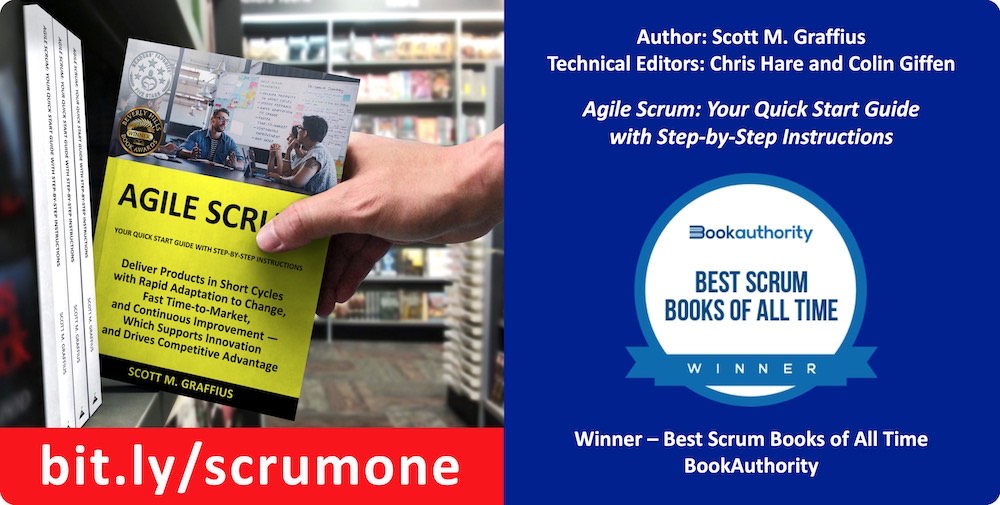
Scott M. Graffius' Agile Scrum: Your Quick Start Guide with Step-by-Step Instructions was named one of the Best Scrum Books of All Time by BookAuthority. A screen shot is available.

About Agile Scrum: Your Quick Start Guide with Step-by-Step Instructions
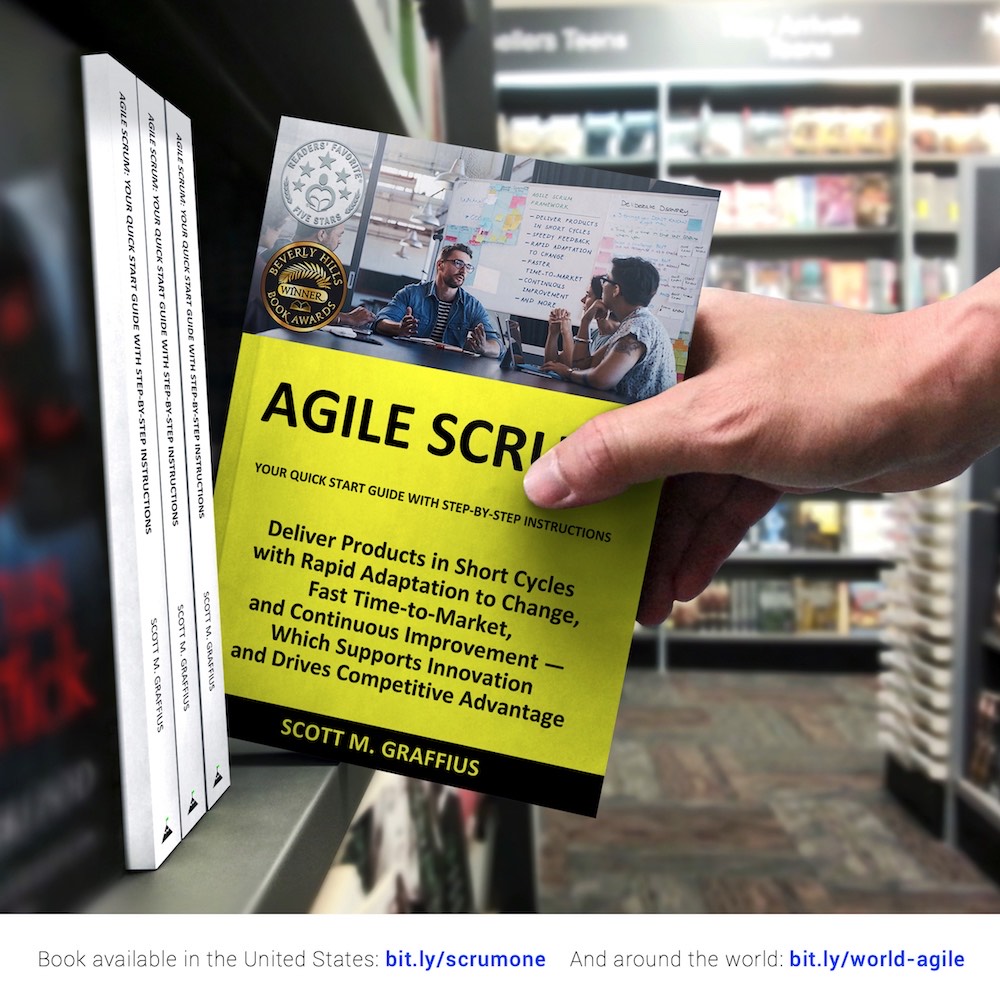
Shifting customer needs are common in today's marketplace. Businesses must be adaptive and responsive to change while delivering an exceptional customer experience to be competitive.
There are a variety of frameworks supporting the development of products and services, and most approaches fall into one of two broad categories: traditional or agile. Traditional practices such as waterfall engage sequential development, while agile involves iterative and incremental deliverables. Organizations are increasingly embracing agile to manage projects, and best meet their business needs of rapid response to change, fast delivery speed, and more.
With clear and easy to follow step-by-step instructions, Scott M. Graffius's award-winning Agile Scrum: Your Quick Start Guide with Step-by-Step Instructions helps the reader:
- Implement and use the most popular agile framework―Scrum;
- Deliver products in short cycles with rapid adaptation to change, fast time-to-market, and continuous improvement; and
- Support innovation and drive competitive advantage.
Hailed by Literary Titan as “the book highlights the versatility of Scrum beautifully.”
Winner of 17 first place awards.
Agile Scrum: Your Quick Start Guide with Step-by-Step Instructions is available in paperback and ebook/Kindle in the United States and around the world. Some links by country follow.
- 🇧🇷 Brazil
- 🇨🇦 Canada
- 🇨🇿 Czech Republic
- 🇩🇰 Denmark
- 🇫🇮 Finland
- 🇫🇷 France
- 🇩🇪 Germany
- 🇬🇷 Greece
- 🇭🇺 Hungary
- 🇮🇳 India
- 🇮🇪 Ireland
- 🇮🇱 Israel
- 🇮🇹 Italy
- 🇯🇵 Japan
- 🇱🇺 Luxembourg
- 🇲🇽 Mexico
- 🇳🇱 Netherlands
- 🇳🇿 New Zealand
- 🇳🇴 Norway
- 🇪🇸 Spain
- 🇸🇪 Sweden
- 🇨🇭 Switzerland
- 🇦🇪 UAE
- 🇬🇧 United Kingdom
- 🇺🇸 United States
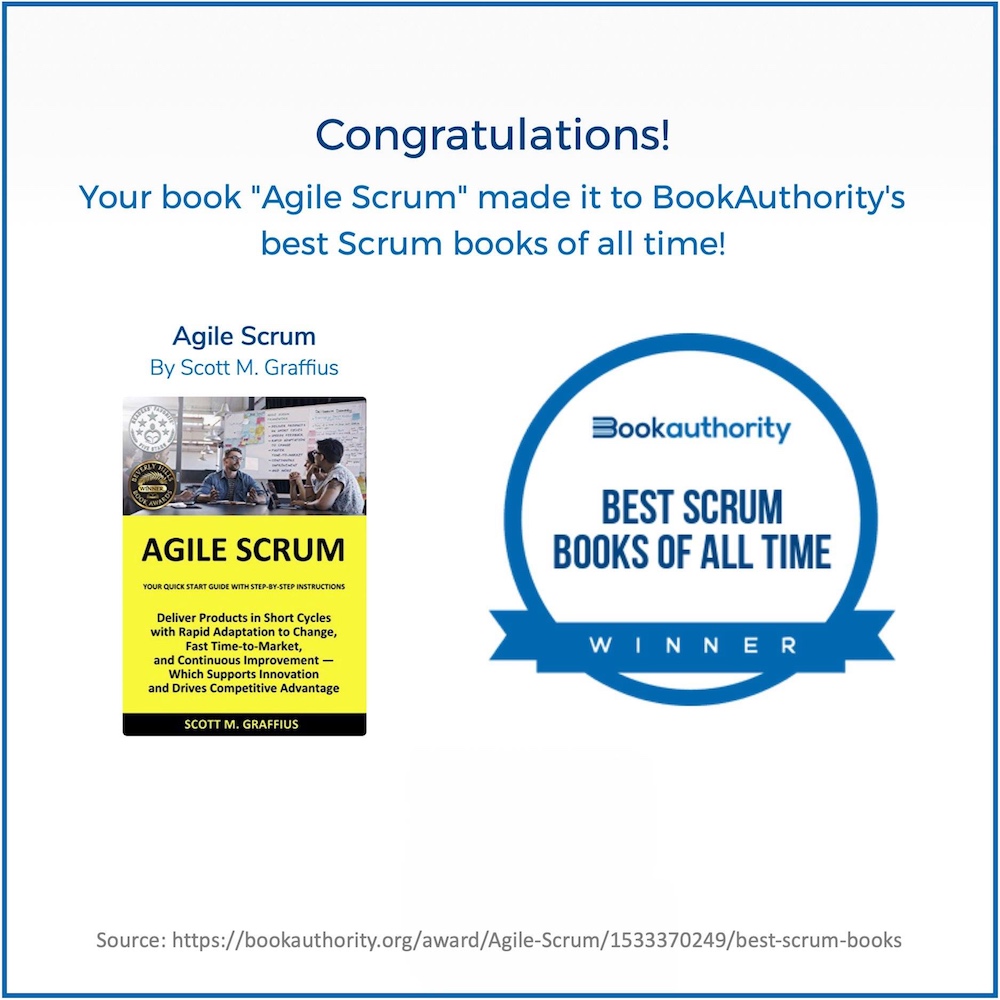

About Author Scott M. Graffius

Scott M. Graffius is a technology leader, project management expert, consultant, international speaker, and award-winning author.
Scott is the CEO of Exceptional PPM and PMO Solutions™, a professional services firm, where he partners with client companies to help them achieve their strategic objectives and business initiatives through project management leadership. The consultancy provides project, program, portfolio, and PMO management services inclusive of agile, traditional, and hybrid development and delivery frameworks. Business results include upgraded responsiveness to business needs, faster delivery and time-to-market, improved on-budget performance, higher customer and stakeholder satisfaction, and greater competitive advantage.
A fantastic agile transformation experience and result with a client in the entertainment industry was the inspiration for Scott’s book, Agile Scrum: Your Quick Start Guide with Step-by-Step Instructions. It helps technical and non-technical teams develop and deliver products in short cycles with rapid adaptation to change, fast time-to-market, and continuous improvement—which supports innovation and drives competitive advantage. The book has garnered 17 first place awards from national and international competitions. Scott and Agile Scrum: Your Quick Start Guide with Step-by-Step Instructions have been featured in Yahoo Finance, the Boston Herald, NBC WRAL, the Dallas Business Journal, the PM World Journal, BookLife by Publisher’s Weekly, Learning Solutions, Innovation Management, and additional media publications. A trailer, high-resolution images, reviews, a detailed list of awards, and more are available in the digital media kit.
Scott is a former vice president of project management with a publicly traded provider of diverse consumer products and services over the Internet. Before that, he ran and supervised the delivery of projects and programs in public and private organizations with businesses ranging from e-commerce to advanced technology products and services, retail, manufacturing, entertainment, and more. He has experience with consumer, business, reseller, government, and international markets, as well as experience spanning 20 countries.
Scott has a bachelor's degree in Psychology with a focus in Human Factors. He holds six professional certifications: Certified Scrum Professional (CSP), Certified ScrumMaster (CSM), Certified Scrum Product Owner (CSPO), Project Management Professional (PMP), Lean Six Sigma Green Belt (LSSGB), and IT Service Management Foundation (ITIL). He is a member of the Scrum Alliance, the Project Management Institute, and the Institute of Electrical and Electronics Engineers (IEEE). Within the IEEE, Graffius is a member of the Computer Society, the Consumer Electronics Society, the Broadcast Technology Society, the Internet of Things Community, and the Consultants Network.
He has been actively involved with the Project Management Institute (PMI) in the development of professional global standards. He was a member of the team which produced the Practice Standard for Work Breakdown Structures—Second Edition. Scott was a contributor and reviewer of A Guide to the Project Management Body of Knowledge—Sixth Edition and The Standard for Program Management—Fourth Edition. He was also a subject matter expert reviewer of content for the PMI EMEA (Europe, Middle East and Africa) Congress 2019.
Scott regularly speaks at conferences and other events in the United States and internationally where he delights audiences with presentations on agile, traditional, and hybrid project, program, portfolio, and PMO management. He integrates content on professional standards, best practices, and his first-hand experience with successful implementations. Scott uses everyday language and custom vibrant visuals to make complex topics clear and understandable, and he provides audiences with practical information they can use. Scott spoke at Techstars Startup Week and at events in London and Las Vegas. He also delivered talks at the Los Angeles chapter of the PMI, the California Central Coast chapter of the PMI, the California Inland Empire chapter of the PMI (two events), and the California Central Valley chapter of the PMI. Attendees have said “Scott is an amazing speaker,” “fantastic presentation,” and “highly recommended!” A list of his past and upcoming appearances (including the Project World conference in Canada, and more) is available here.
His full bio is available here.
Connect with Scott on:
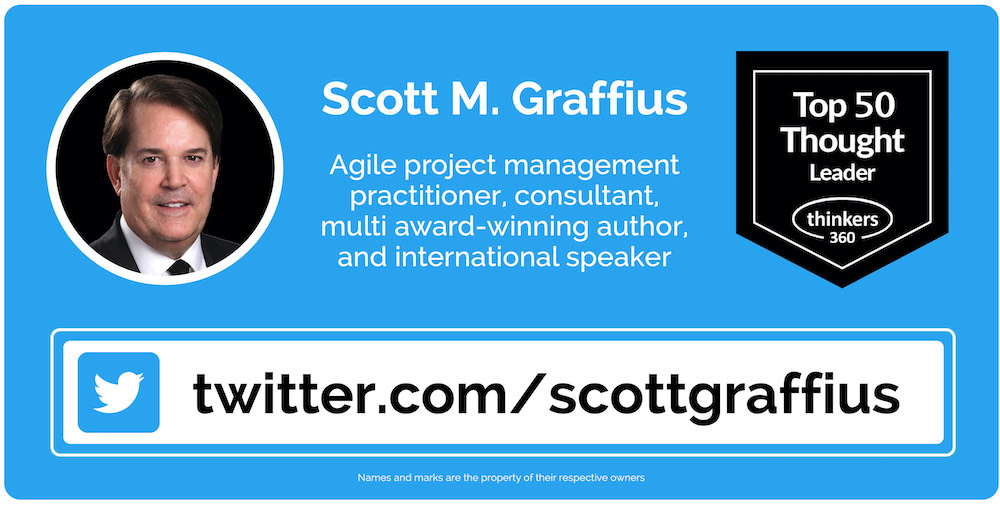

About BookAuthority
BookAuthority curates the books recommended by the world's most successful CEOs, business leaders, and domain experts such as Elon Musk, Warren Buffett, Sheryl Sandberg, and David Allen. Only the very best books are featured on BookAuthority. To keep BookAuthority's site objective and unbiased, ratings are calculated purely based on data. BookAuthority uses a proprietary technology to identify and rate the best nonfiction books, using dozens of different signals, including public mentions, recommendations, ratings, sentiment, popularity and sales history. BookAuthority does not accept requests to feature books, nor does BookAuthority conduct business with publishers or authors. BookAuthority has been featured on CNN, Forbes and Inc. The preceding information is based on content from BookAuthority.com.

© Copyright 2019 Scott M. Graffius. All rights reserved. This material may not be published, broadcast, rewritten or redistributed without the express written permission of Scott M. Graffius.

"Agile Scrum" Now Available to Wider Audience Through More Retailers, Bookstores, Libraries, Academic Institutions, and Distributors
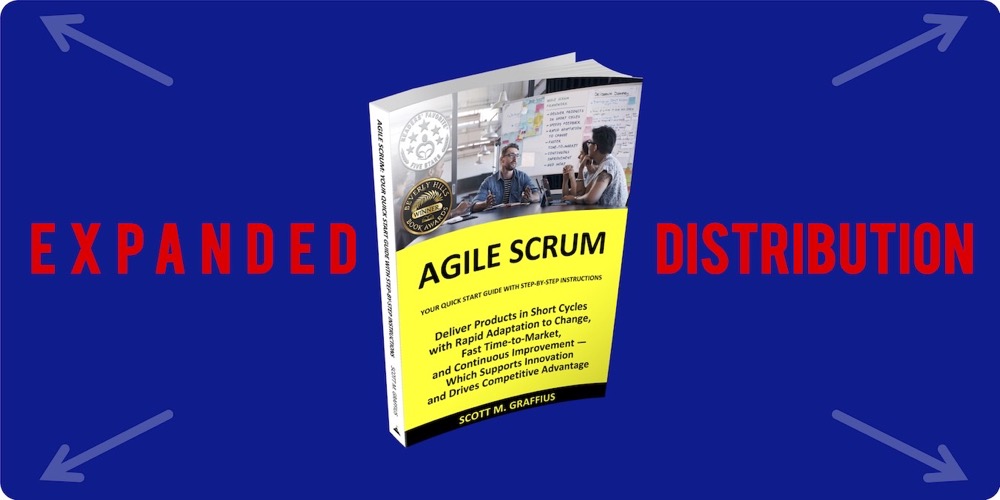
Agile Scrum: Your Quick Start Guide with Step-by-Step Instructions (Scott M. Graffius, author; Chris Hare and Colin Giffen, technical editors) helps teams deliver products and services in short cycles with rapid adaptation to change, fast time-to-market, and continuous improvement—which supports innovation and drives competitive advantage. Reactions to the book have been incredibly positive. It has won 17 first place awards.
I've been proud to have Amazon as the exclusive channel for Agile Scrum. Last month I received an email from a bookstore who wanted to carry the publication and asked about ordering it for resale. And on Monday of this week, a different bookstore called and had the same question. However, under the exclusive arrangement, distribution was limited to Amazon, and the bookstores were not able to get Agile Scrum for resale. To make the book available to those sellers—and others—I transitioned it to Expanded Distribution.
Both the print and ebook formats of Agile Scrum will still be available at Amazon, just not exclusively. Expanded Distribution provides access to a larger audience through more online retailers, bookstores, libraries, academic institutions, and distributors. With the change, Agile Scrum is now available for order through the following channels (in addition to Amazon):
- Bookstores and Online Retailers - available to online and offline retailers such as Barnes & Noble and to distributors such as Ingram and the National Association of College Stores, Inc. (NACSCORP).
- Libraries and Academic Institutions - offered through Baker & Taylor to libraries and academic institutions.
- CreateSpace Direct - available to certified resellers through the CreateSpace Direct wholesale website.
The move to Expanded Distribution was initiated on July 5.
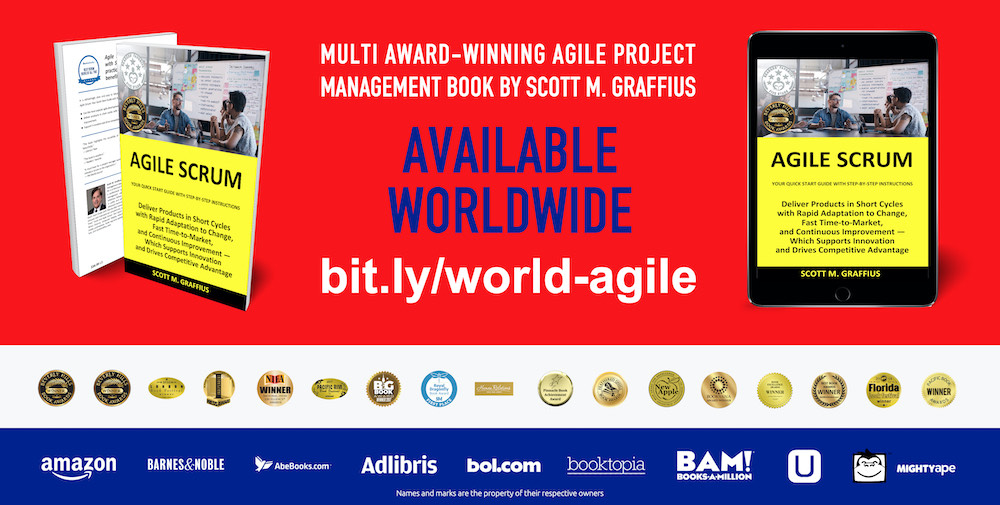
Agile Scrum is offered in ebook/Kindle format (ASIN: B01FZ0JIIY) in:
🇦🇺 Australia from Amazon.com.au
🇦🇹 Austria from Amazon.de
🇧🇪 Belgium from Amazon.fr
🇧🇷 Brazil from Amazon.com.br
🇨🇦 Canada from Amazon.ca
🇫🇷 France from Amazon.fr
🇩🇪 Germany from Amazon.de
🇮🇳 India from Amazon.in
🇮🇪 Ireland from Amazon.co.uk
🇮🇹 Italy from Amazon.it
🇯🇵 Japan from Amazon.co.jp
🇱🇮 Liechtenstein from Amazon.de
🇱🇺 Luxembourg from Amazon.de
🇲🇽 Mexico from Amazon.com.mx
🇲🇨 Monaco from Amazon.fr
🇳🇱 Netherlands from Amazon.nl
🇳🇿 New Zealand from Amazon.com.au
🇸🇲 San Marino from Amazon.it
🇪🇸 Spain from Amazon.es
🇨🇭 Switzerland from Amazon.de
🇬🇧 United Kingdom from Amazon.co.uk
🇺🇸 United States of America from Amazon.com
🇻🇦 Vatican City from Amazon.it
Agile Scrum is sold in paperback (ISBN-13: 9781533370242) in:
🇦🇼 Aruba from The Book Depository (via UK/Australia)
🇦🇺 Australia from Amazon.com.au
🇦🇹 Austria from Bokus.com (via Sweden)
🇧🇸 Bahamas from The Book Depository (via UK/Australia)
🇧🇪 Belgium from Bokus.com (via Sweden)
🇨🇦 Canada from Amazon.ca
🇨🇿 Czech Republic from Bokus.com (via Sweden)
🇩🇰 Denmark from The Book Depository (via UK/Australia)
🇫🇯 Fiji from The Book Depository (via UK/Australia)
🇫🇮 Finland from Bokus.com (via Sweden)
🇫🇷 France from Amazon.fr
🇩🇪 Germany from Amazon.de
🇬🇷 Greece from Bokus.com (via Sweden)
🇭🇺 Hungary from Bokus.com (via Sweden)
🇮🇸 Iceland from Bokus.com (via Sweden)
🇮🇳 India from Amazon.in
🇮🇪 Ireland from Amazon.co.uk
🇮🇱 Israel from The Book Depository (via UK/Australia)
🇮🇹 Italy from Amazon.it
🇯🇲 Jamaica from The Book Depository (via UK/Australia)
🇯🇵 Japan from Amazon.co.jp
🇱🇺 Luxembourg from Bokus.com (via Sweden)
🇲🇽 Mexico from Amazon.com.mx
🇲🇨 Monaco from Bokus.com (via Sweden)
🇳🇱 Netherlands from bol.com
🇳🇿 New Zealand from Fishpond.co.nz, Amazon.com (via USA), and Booktopia.com.au (via Australia)
🇳🇴 Norway from Bokus.com (via Sweden)
🇵🇪 Peru from The Book Depository (via UK/Australia)
🇵🇭 Philippines from The Book Depository (via UK/Australia)
🇵🇷 Puerto Rico from The Book Depository (via UK/Australia)
🇸🇬 Singapore from OpenTrolley Bookstore
🇿🇦 South Africa from Loot.co.za
🇰🇷 South Korea from Bokus.com (via Sweden)
🇪🇸 Spain from Amazon.es
🇸🇪 Sweden from Adlibris.com
🇨🇭 Switzerland from Bokus.com (via Sweden)
🇺🇦 Ukraine from The Book Depository (via UK/Australia)
🇦🇪 United Arab Emirates from Amazon.ae
🇬🇧 United Kingdom from Amazon.co.uk, Blackwell's, and The Book Depository
🇺🇸 United States of America from Amazon.com, Barnes & Noble, AbeBooks, Books-a-Million, Diesel Bookstore (Santa Monica, California), Laguna Beach Books (Laguna Beach, California), Warwick’s (La Jolla, California), The Booksmith (San Francisco, California), University Press Books (Berkeley, California), Compass Books at SFO/Books Inc. (San Francisco, California), University of Arizona Bookstore (Tucson, Arizona), Strand Books (New York, New York), Hudson Booksellers (New York, New York), Harvard Book Store (Cambridge, Massachusetts), Savoy Bookshop & Café (Westerly, Rhode Island), Books & Books (Miami, Florida), and others
🇻🇳 Vietnam from U-buy.vn
Get your copy today!
Review copies of Agile Scrum are available to members of broadcast, print or online media. Visit http://bit.ly/REVIEW-COPY.
For more information on the book and to connect on social:
- Digital press kit https://AgileScrumGuide.com
- Trailer http://bit.ly/ASG-TRAILER
- Video channel https://bit.ly/ASG-CHANNEL
- Amazon https://amzn.to/2fVA3lW
- Twitter http://bit.ly/ASG-TWITTER
- Facebook https://bit.ly/ASG-ON-FB
- Instagram https://bit.ly/ASG-INSTA
- Pinterest http://bit.ly/ASG-PIN
- Blog https://bit.ly/AGILE-BLOG

© Copyright 2018 Scott M. Graffius. All rights reserved. This material may not be published, broadcast, rewritten or redistributed.

Scott M. Graffius to Speak on Agile Scrum at Techstars Startup Week - Inland Empire
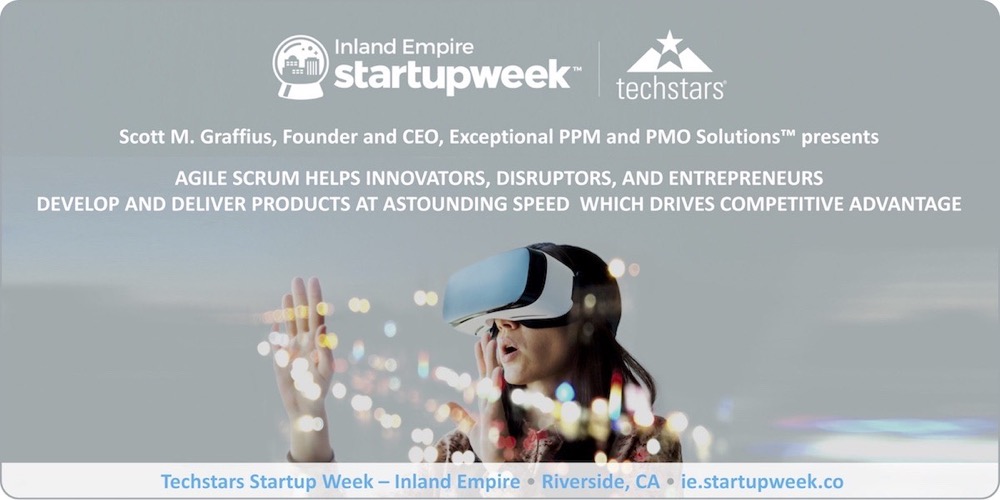
Scott M. Graffius, CEO of Exceptional PPM and PMO Solutions™, will be speaking at Techstars Startup Week. He will be presenting "Agile Scrum Helps Innovators, Disruptors, and Entrepreneurs Develop and Deliver Products at Astounding Speed Which Drives Competitive Advantage." The talk will be held at 2:00 p.m. on Thursday, October 4, 2018 at The Box Riverside (also known as The Box Theater) in Riverside, CA. For more information and to register for the event, please visit https://ie.startupweek.co.
Techstars Startup Week provides presentations, workshops, events, and mentoring sessions designed to inspire, educate, and advance startups and others in the local entrepreneurial community.
Exceptional PPM and PMO Solutions™ helps organizations achieve their strategic objectives and business initiatives via world-class project management. The firm provides expert advisory, training, and facilitative consulting services related to project, program, portfolio, and PMO management in agile, traditional/waterfall, and hybrid development and delivery frameworks.

© Copyright 2018 Scott M. Graffius. All rights reserved. This material may not be published, broadcast, rewritten or redistributed without the express written permission of Scott M. Graffius.

The Importance of Managing Work in Progress (WIP)
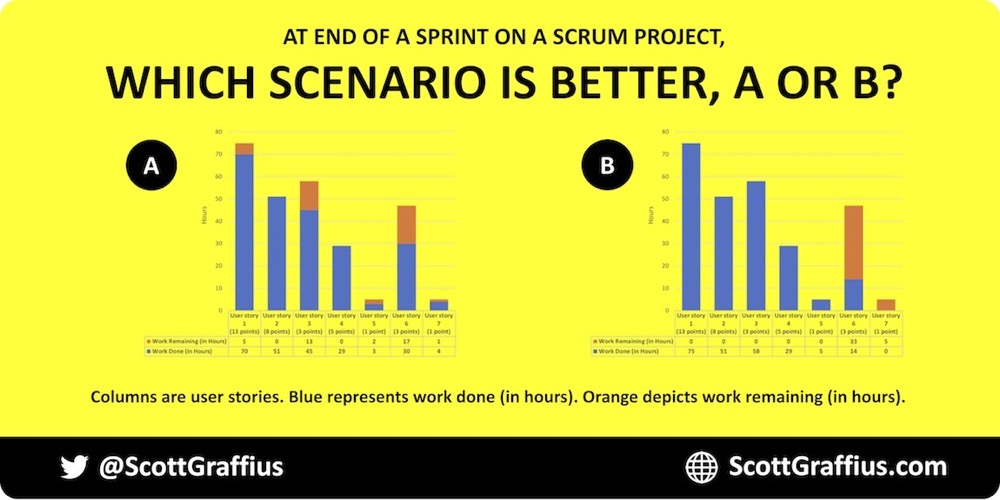
The following example illustrates the importance of managing work in progress (WIP). While the scenarios pertain to a Scrum project, the point applies to other types of projects—such as Kanban and SAFe—as well.
Take a look at the results at the end of a sprint on a Scrum project. There are two scenarios. Both have the same user stories with the same story points for each:
- User story 1: 13 story points
- User story 2: 8 story points
- User story 3: 3 story points
- User story 4: 5 story points
- User story 5: 1 story point
- User story 6: 3 story points
- User story 7: 1 story point
Scenario A
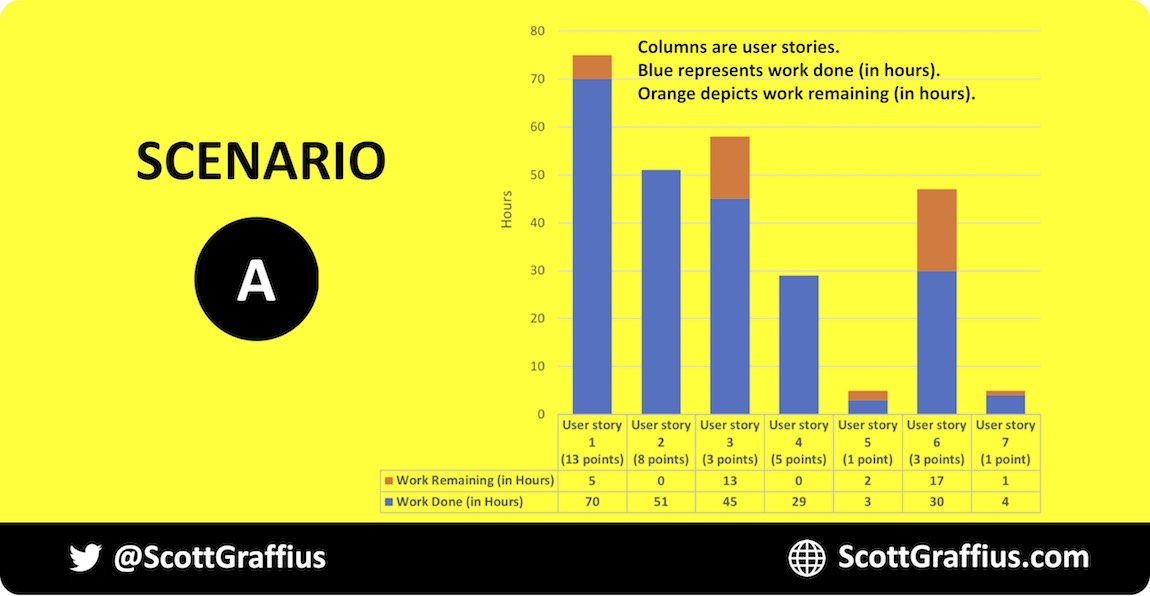
Here are some details on A:
- User story 1: 70 hours of work performed, 5 hours of work remaining
- User story 2: 51 hours of work performed, no work remaining (and it meets the Definition of Done [DoD])
- User story 3: 45 hours of work performed, 13 hours of work remaining
- User story 4: 29 hours of work performed, no work remaining (and it meets the DoD)
- User story 5: 3 hours of work performed, 2 hours of work remaining
- User story 6: 30 hours of work performed, 17 hours of work remaining
- User story 7: 4 hours of work performed, 1 hour of work remaining
A is summarized as:
- 232 hours of work was performed, and 38 hours of work remains
- 2 user stories were done, and 5 user stories were not completed
Scenario B
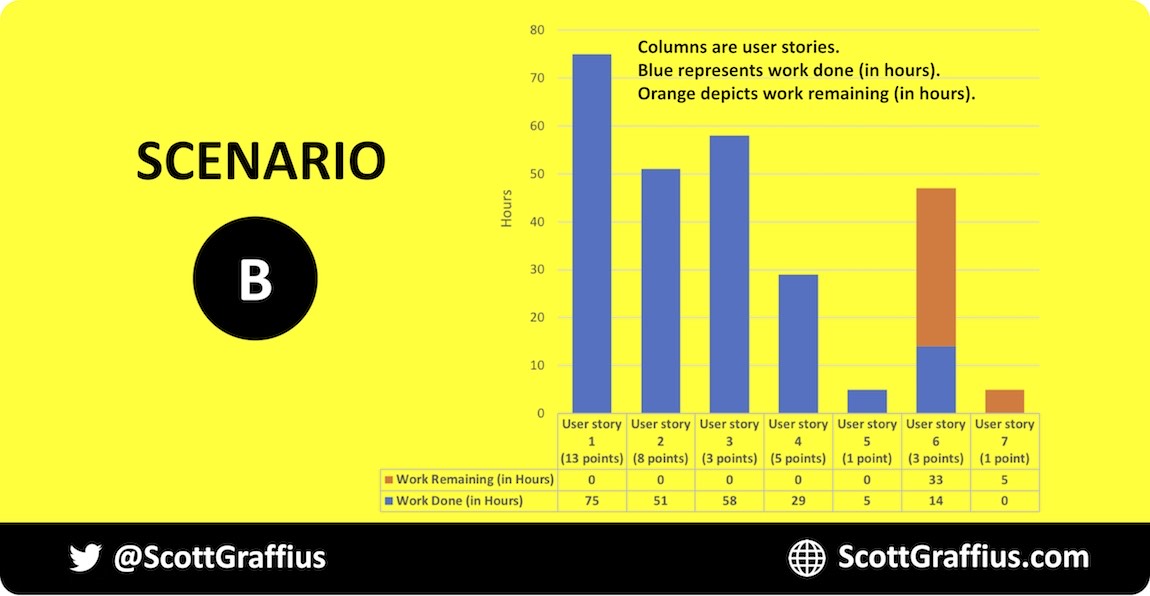
Here are some details on B:
- User story 1: 75 hours of work performed, no work remaining (and it meets the DoD)
- User story 2: 51 hours of work performed, no work remaining (and it meets the DoD)
- User story 3: 58 hours of work performed, no work remaining (and it meets the DoD)
- User story 4: 29 hours of work performed, no work remaining (and it meets the DoD)
- User story 5: 5 hours of work performed, no work remaining (and it meets the DoD)
- User story 6: 14 hours of work performed, 33 hours of work remaining
- User story 5: no work performed, and five hours of work remaining
B is summarized as:
- 232 hours of work was performed, and 38 hours of work remains
- 5 user stories were done, and 2 user stories were not completed
What Counts
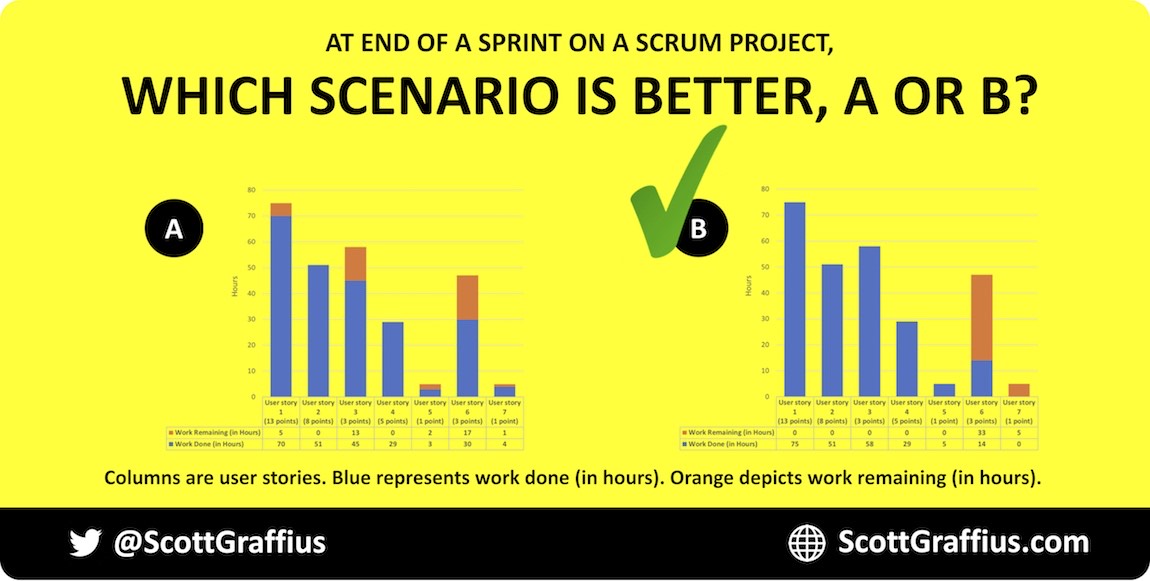
Scrum requires teams to build an increment of functionality during every sprint. Only work meeting the Definition of Done (DoD) is counted as complete, demonstrated at the sprint review meeting, and is potentially shippable.
There were two scenarios. Both had the same user stories with the same story points for each, and the same amount of work hours performed. Yet the outcomes were dramatically different. In A, 2 user stories were done--and are to be demonstrated at the sprint review meeting, and are potentially shippable. In B, 5 user stories were done--and are to be demonstrated at the sprint review meeting, and are potentially shippable. B is the better scenario.
A possible explanation for the differences between the two situations is that the Scrum team in B may have done a better job of limiting Work in Progress.


To learn more about agile/Scrum, check out the award-winning book, Agile Scrum: Your Quick Start Guide with Step-by-Step Instructions. You're invited to visit the digital press kit, watch the trailer, and pick up a copy of the publication. It’s offered in digital and print formats.
The ebook (ASIN: B01FZ0JIIY) is available in:
- Australia,
- Brazil,
- Canada,
- France,
- Germany,
- India,
- Italy,
- Japan,
- Mexico,
- the Netherlands,
- Spain,
- the United Kingdom, and
- the United States.
The paperback (ISBN-13: 9781533370242) is for sale at:
- Amazon,
- Barnes & Noble,
- Strand Books,
- Harvard Book Store,
- Books-a-Million,
- The Booksmith,
- Hudson Booksellers,
- Savoy Bookshop & Café,
- Compass Books at SFO/Books Inc.,
- Books & Books - Miami,
- University Press Books - Berkeley,
- and other retailers and partners in the United States and around the world.

© Copyright 2018 Scott M. Graffius. All rights reserved. This material may not be published, broadcast, rewritten or redistributed without the express written permission of Scott M. Graffius.

"Agile Scrum" Book Trailer — Updated on 13 April 2018
Agile Scrum Guide | Official Book Trailer from Scott Graffius on Vimeo.
Scott M. Graffius of Exceptional PPM and PMO Solutions™ had consulting engagements with a division of a global entertainment business. A fantastic agile transformation experience with that client was the inspiration for his book, Agile Scrum: Your Quick Start Guide with Step-by-Step Instructions. This is an update on the book.
The new book trailer for Agile Scrum is live at https://vimeo.com/178858753 (and it can be played above). This new version highlights some editorial reviews, and it features fresh music and additional updates. The total run time is 1 minute.

Agile Scrum: Your Quick Start Guide with Step-by-Step Instructions is offered in digital and print formats.
The ebook (ASIN: B01FZ0JIIY) is available in:
- Australia,
- Brazil,
- Canada,
- France,
- Germany,
- India,
- Italy,
- Japan,
- Mexico,
- the Netherlands,
- Spain,
- the United Kingdom, and
- the United States.
The paperback (ISBN-13: 9781533370242) is for sale at:
- Amazon,
- Barnes & Noble,
- Strand Books,
- Harvard Book Store,
- Books-a-Million,
- The Booksmith,
- Hudson Booksellers,
- Savoy Bookshop & Café,
- Compass Books at SFO/Books Inc.,
- Books & Books - Miami,
- University Press Books - Berkeley,
- and other retailers and partners in the United States and around the world.

© Copyright 2018 Scott M. Graffius. All rights reserved. This material may not be published, broadcast, rewritten or redistributed without the express written permission of Scott M. Graffius.

“Agile Scrum" Guide Nabs Silver Medal from Readers' Favorite International Book Awards
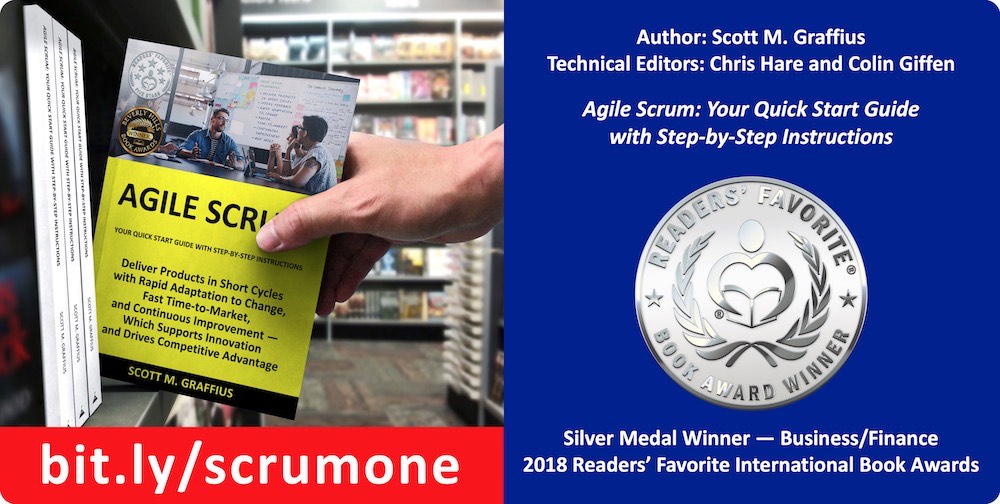
Scott M. Graffius of Exceptional PPM and PMO Solutions™ had consulting engagements with a division of a global entertainment business. A fantastic agile transformation experience and result with that client was the inspiration for Scott's book, Agile Scrum: Your Quick Start Guide with Step-by-Step Instructions. This is an update on the book.
Agile Scrum won the silver medal in the Business/Finance category at the 2018 Readers' Favorite International Book Awards. A press release from Scott is located here and the news is presented below as well.
★★★★★
Agile Scrum: Your Quick Start Guide with Step-by-Step Instructions by Scott M. Graffius helps technical and non-technical teams develop and deliver products at astounding speed with rapid adaptation to change and continuous improvement which supports innovation and drives competitive advantage. Reactions to the book have been incredibly positive. The latest accolade comes from the 2018 Readers' Favorite International Book Awards (https://readersfavorite.com/2018-award-contest-winners.htm), which awarded Agile Scrum with the silver medal in the Business/Finance category. With thousands of entries ranging from New York Times bestsellers to works from first-time self-published authors, the program is one of the largest book competitions. Graffius will be presented with the silver medal on stage at a gala in Miami, Florida on Saturday, November 17, 2018.

About the Author

Scott M. Graffius, PMP, CSP, CSM, CSPO, ITIL, LSSGB is a project management expert, consultant, author, and international speaker. He is the Founder and CEO of Exceptional PPM and PMO Solutions™, a management consulting firm. Scott is a former vice president of project management with a publicly traded provider of diverse consumer products and services over the Internet. Before that, he ran and supervised the delivery of projects and programs in public and private organizations with businesses ranging from e-commerce to advanced technology products and services, retail, manufacturing, entertainment, and more.
His full bio is available here.
Connect with Scott on:


About Agile Scrum: Your Quick Start Guide with Step-by-Step Instructions

Shifting customer needs are common in today's marketplace. Businesses must be adaptive and responsive to change while delivering an exceptional customer experience to be competitive.
There are a variety of frameworks supporting the development of products and services, and most approaches fall into one of two broad categories: traditional or agile. Traditional practices such as waterfall engage sequential development, while agile involves iterative and incremental deliverables. Organizations are increasingly embracing agile to manage projects, and best meet their business needs of rapid response to change, fast delivery speed, and more.
With clear and easy to follow step-by-step instructions, Scott M. Graffius's award-winning Agile Scrum: Your Quick Start Guide with Step-by-Step Instructions helps the reader:
- Implement and use the most popular agile framework―Scrum;
- Deliver products in short cycles with rapid adaptation to change, fast time-to-market, and continuous improvement; and
- Support innovation and drive competitive advantage.
Hailed by Literary Titan as “the book highlights the versatility of Scrum beautifully.”
Winner of 17 first place awards.
Agile Scrum: Your Quick Start Guide with Step-by-Step Instructions is available in paperback and ebook/Kindle in the United States and around the world. Some links by country follow.
- 🇧🇷 Brazil
- 🇨🇦 Canada
- 🇨🇿 Czech Republic
- 🇩🇰 Denmark
- 🇫🇮 Finland
- 🇫🇷 France
- 🇩🇪 Germany
- 🇬🇷 Greece
- 🇭🇺 Hungary
- 🇮🇳 India
- 🇮🇪 Ireland
- 🇮🇱 Israel
- 🇮🇹 Italy
- 🇯🇵 Japan
- 🇱🇺 Luxembourg
- 🇲🇽 Mexico
- 🇳🇱 Netherlands
- 🇳🇿 New Zealand
- 🇳🇴 Norway
- 🇪🇸 Spain
- 🇸🇪 Sweden
- 🇨🇭 Switzerland
- 🇦🇪 UAE
- 🇬🇧 United Kingdom
- 🇺🇸 United States

About Exceptional PPM and PMO Solutions
Exceptional PPM and PMO Solutions™ (http://Exceptional-PMO.com) helps organizations achieve their strategic objectives and business initiatives via world-class project management. The firm provides expert advisory, training, and facilitative consulting services related to project, program, portfolio, and PMO management in agile, traditional, and hybrid development and delivery frameworks.

© Copyright 2018 Scott M. Graffius. All rights reserved. This material may not be published, broadcast, rewritten or redistributed without the express written permission of Scott M. Graffius.

Yahoo Finance: Scott M. Graffius to Speak on Agile Scrum at Techstars Startup Week
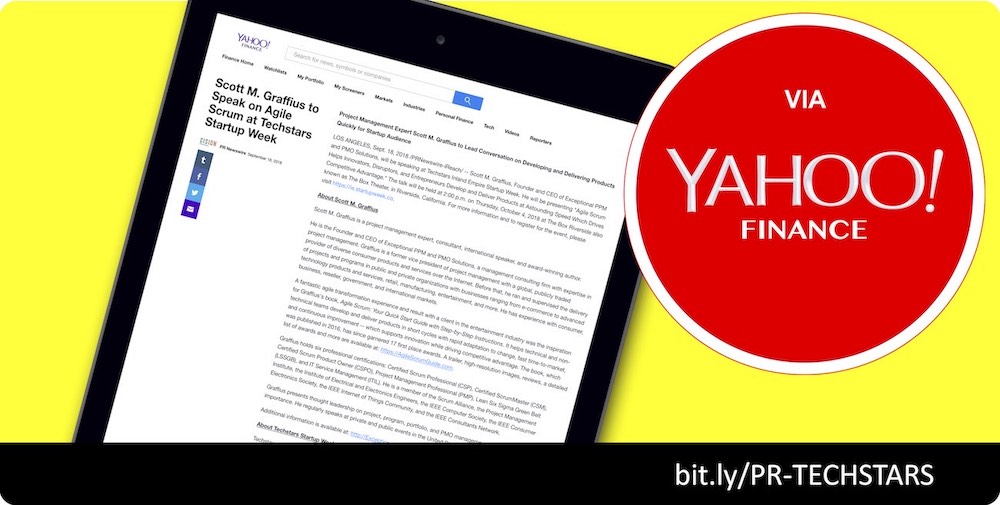
Scott M. Graffius, Founder and CEO of Exceptional PPM and PMO Solutions™, will be speaking at Techstars Startup Week. A press release, distributed today, was carried by Yahoo Finance and other media outlets. You can read it on Yahoo Finance here.

© Copyright 2018 Scott M. Graffius. All rights reserved. This material may not be published, broadcast, rewritten or redistributed without the express written permission of Scott M. Graffius.

Scott M. Graffius Featured in Success Story by BEA
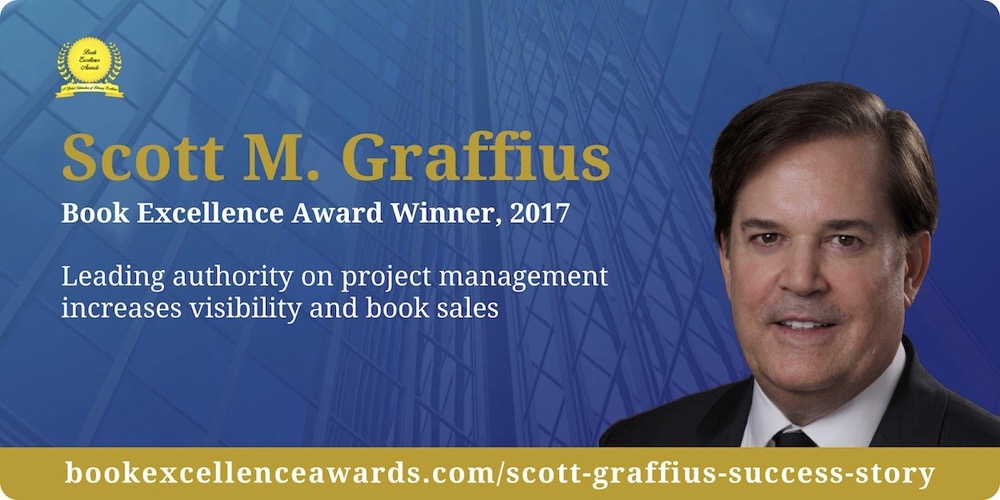
The Book Excellence Awards features Scott M. Graffius, author of Agile Scrum: Your Quick Start Guide with Step-by-Step Instructions, in a story. The article highlights factors contributing to the book's success — including credit to Chris Hare and Colin Giffen, the technical editors on the publication. You can check out the story at https://www.bookexcellenceawards.com/scott-graffius-success-story.
About Agile Scrum: Your Quick Start Guide with Step-by-Step Instructions

Shifting customer needs are common in today's marketplace. Businesses must be adaptive and responsive to change while delivering an exceptional customer experience to be competitive.
There are a variety of frameworks supporting the development of products and services, and most approaches fall into one of two broad categories: traditional or agile. Traditional practices such as waterfall engage sequential development, while agile involves iterative and incremental deliverables. Organizations are increasingly embracing agile to manage projects, and best meet their business needs of rapid response to change, fast delivery speed, and more.
With clear and easy to follow step-by-step instructions, Scott M. Graffius's award-winning Agile Scrum: Your Quick Start Guide with Step-by-Step Instructions helps the reader:
- Implement and use the most popular agile framework―Scrum;
- Deliver products in short cycles with rapid adaptation to change, fast time-to-market, and continuous improvement; and
- Support innovation and drive competitive advantage.
Hailed by Literary Titan as “the book highlights the versatility of Scrum beautifully.”
Winner of 17 first place awards.
Agile Scrum: Your Quick Start Guide with Step-by-Step Instructions is available in paperback and ebook/Kindle in the United States and around the world. Some links by country follow.
- 🇧🇷 Brazil
- 🇨🇦 Canada
- 🇨🇿 Czech Republic
- 🇩🇰 Denmark
- 🇫🇮 Finland
- 🇫🇷 France
- 🇩🇪 Germany
- 🇬🇷 Greece
- 🇭🇺 Hungary
- 🇮🇳 India
- 🇮🇪 Ireland
- 🇮🇱 Israel
- 🇮🇹 Italy
- 🇯🇵 Japan
- 🇱🇺 Luxembourg
- 🇲🇽 Mexico
- 🇳🇱 Netherlands
- 🇳🇿 New Zealand
- 🇳🇴 Norway
- 🇪🇸 Spain
- 🇸🇪 Sweden
- 🇨🇭 Switzerland
- 🇦🇪 UAE
- 🇬🇧 United Kingdom
- 🇺🇸 United States

© Copyright 2018 Scott M. Graffius. All rights reserved. This material may not be published, broadcast, rewritten or redistributed without the express written permission of Scott M. Graffius.

"Agile Scrum: Your Quick Start Guide with Step-by-Step Instructions" Featured in Presentation at DX Summit
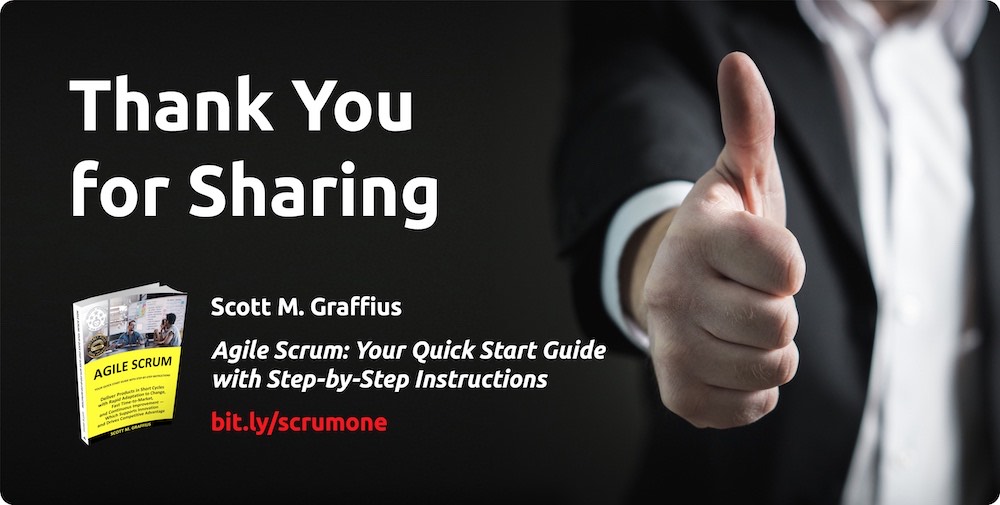
I’m pleased to have had content from Agile Scrum: Your Quick Start Guide with Step-by-Step Instructions (bit.ly/scrumone) featured by Eeshita Grover, Senior Manager at Cisco, in her presentation at DX Summit. The conference serves customer experience and digital marketing leaders tackling voice of the customer, machine learning and AI, big data and analytics, optimization, and digital experience challenges.
Eeshita Grover’s talk was on November 14, 2018 and her presentation (https://www.slideshare.net/DXSummit/building-a-uex-strategy-for-inproduct-selfhelp-eeshita-grover) included 14 slides. Slide 13 featured content from the book:
“If you don’t collect any metrics, you’re flying blind. If you collect and focus on too many, they may be obstructing your field of view.”
— Scott M. Graffius, Agile Scrum: Your Quick Start Guide with Step-by-Step Instructions

About Author Scott M. Graffius

Scott M. Graffius, CSP, CSM, CSPO, PMP, ITIL, LSSGB is a project management expert, consultant, international speaker, and award-winning author. He is the CEO of Exceptional PPM and PMO Solutions, a professional services firm, where he partners with client companies to help them achieve their strategic objectives and business initiatives through project management leadership. The consultancy provides project, program, portfolio, and PMO management services inclusive of agile, traditional, and hybrid development and delivery frameworks. Business results include upgraded responsiveness to business needs, faster delivery and time-to-market, improved on-budget performance, higher customer and stakeholder satisfaction, and greater competitive advantage. Scott is a former vice president of project management with a publicly traded provider of diverse consumer products and services over the Internet. Before that, he ran and supervised the delivery of projects and programs in public and private organizations with businesses ranging from e-commerce to advanced technology products and services, retail, manufacturing, entertainment, and more. He has experience with consumer, business, reseller, government, and international markets.
His full bio is available here.
Connect with Scott on:


About Agile Scrum: Your Quick Start Guide with Step-by-Step Instructions

Shifting customer needs are common in today's marketplace. Businesses must be adaptive and responsive to change while delivering an exceptional customer experience to be competitive.
There are a variety of frameworks supporting the development of products and services, and most approaches fall into one of two broad categories: traditional or agile. Traditional practices such as waterfall engage sequential development, while agile involves iterative and incremental deliverables. Organizations are increasingly embracing agile to manage projects, and best meet their business needs of rapid response to change, fast delivery speed, and more.
With clear and easy to follow step-by-step instructions, Scott M. Graffius's award-winning Agile Scrum: Your Quick Start Guide with Step-by-Step Instructions helps the reader:
- Implement and use the most popular agile framework―Scrum;
- Deliver products in short cycles with rapid adaptation to change, fast time-to-market, and continuous improvement; and
- Support innovation and drive competitive advantage.
Hailed by Literary Titan as “the book highlights the versatility of Scrum beautifully.”
Winner of 17 first place awards.
Agile Scrum: Your Quick Start Guide with Step-by-Step Instructions is available in paperback and ebook/Kindle in the United States and around the world. Some links by country follow.
- 🇧🇷 Brazil
- 🇨🇦 Canada
- 🇨🇿 Czech Republic
- 🇩🇰 Denmark
- 🇫🇮 Finland
- 🇫🇷 France
- 🇩🇪 Germany
- 🇬🇷 Greece
- 🇭🇺 Hungary
- 🇮🇳 India
- 🇮🇪 Ireland
- 🇮🇱 Israel
- 🇮🇹 Italy
- 🇯🇵 Japan
- 🇱🇺 Luxembourg
- 🇲🇽 Mexico
- 🇳🇱 Netherlands
- 🇳🇿 New Zealand
- 🇳🇴 Norway
- 🇪🇸 Spain
- 🇸🇪 Sweden
- 🇨🇭 Switzerland
- 🇦🇪 UAE
- 🇬🇧 United Kingdom
- 🇺🇸 United States

© Copyright 2019 Scott M. Graffius. All rights reserved. This material may not be published, broadcast, rewritten or redistributed without the express written permission of Scott M. Graffius.

Content from "Agile Scrum: Your Quick Start Guide with Step-by-Step Instructions" Featured in Article from Learning Solutions
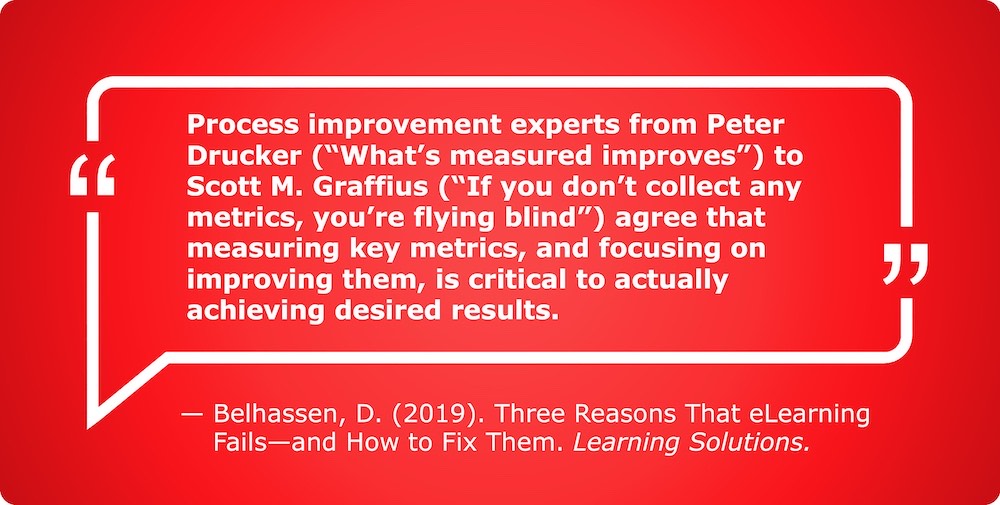
Content from Scott M. Graffius' Agile Scrum: Your Quick Start Guide with Step-by-Step Instructions appeared in Three Reasons That eLearning Fails—and How to Fix Them, published in Learning Solutions. Here's an excerpt from the article by Dan Belhassen:
"Process improvement experts from Peter Drucker ("What's measured improves") to Scott M. Graffius ("If you don't collect any metrics, you're flying blind") agree that measuring key metrics, and focusing on improving them, is critical to actually achieving desired results."
The article is available online here: https://www.learningsolutionsmag.com/articles/3-reasons-that-elearning-fails-and-how-to-fix-them/.

About Author Scott M. Graffius

Scott M. Graffius, CSP, CSM, CSPO, PMP, ITIL, LSSGB is a project management expert, consultant, international speaker, and award-winning author. He is the CEO of Exceptional PPM and PMO Solutions, a professional services firm, where he partners with client companies to help them achieve their strategic objectives and business initiatives through project management leadership. The consultancy provides project, program, portfolio, and PMO management services inclusive of agile, traditional, and hybrid development and delivery frameworks. Business results include upgraded responsiveness to business needs, faster delivery and time-to-market, improved on-budget performance, higher customer and stakeholder satisfaction, and greater competitive advantage. Scott is a former vice president of project management with a publicly traded provider of diverse consumer products and services over the Internet. Before that, he ran and supervised the delivery of projects and programs in public and private organizations with businesses ranging from e-commerce to advanced technology products and services, retail, manufacturing, entertainment, and more. He has experience with consumer, business, reseller, government, and international markets.
His full bio is available here.
Connect with Scott on:


About Agile Scrum: Your Quick Start Guide with Step-by-Step Instructions

Shifting customer needs are common in today's marketplace. Businesses must be adaptive and responsive to change while delivering an exceptional customer experience to be competitive.
There are a variety of frameworks supporting the development of products and services, and most approaches fall into one of two broad categories: traditional or agile. Traditional practices such as waterfall engage sequential development, while agile involves iterative and incremental deliverables. Organizations are increasingly embracing agile to manage projects, and best meet their business needs of rapid response to change, fast delivery speed, and more.
With clear and easy to follow step-by-step instructions, Scott M. Graffius's award-winning Agile Scrum: Your Quick Start Guide with Step-by-Step Instructions helps the reader:
- Implement and use the most popular agile framework―Scrum;
- Deliver products in short cycles with rapid adaptation to change, fast time-to-market, and continuous improvement; and
- Support innovation and drive competitive advantage.
Hailed by Literary Titan as “the book highlights the versatility of Scrum beautifully.”
Winner of 17 first place awards.
Agile Scrum: Your Quick Start Guide with Step-by-Step Instructions is available in paperback and ebook/Kindle in the United States and around the world. Some links by country follow.
- 🇧🇷 Brazil
- 🇨🇦 Canada
- 🇨🇿 Czech Republic
- 🇩🇰 Denmark
- 🇫🇮 Finland
- 🇫🇷 France
- 🇩🇪 Germany
- 🇬🇷 Greece
- 🇭🇺 Hungary
- 🇮🇳 India
- 🇮🇪 Ireland
- 🇮🇱 Israel
- 🇮🇹 Italy
- 🇯🇵 Japan
- 🇱🇺 Luxembourg
- 🇲🇽 Mexico
- 🇳🇱 Netherlands
- 🇳🇿 New Zealand
- 🇳🇴 Norway
- 🇪🇸 Spain
- 🇸🇪 Sweden
- 🇨🇭 Switzerland
- 🇦🇪 UAE
- 🇬🇧 United Kingdom
- 🇺🇸 United States

© Copyright 2019 Scott M. Graffius. All rights reserved. This material may not be published, broadcast, rewritten or redistributed without the express written permission of Scott M. Graffius.

Agile Transformation at an International Media Conglomerate: Based on a True Story | Part One

Agile Transformation at an International Media Conglomerate: Based on a True Story
Scott M. Graffius, CEO of Exceptional PPM and PMO Solutions™, helps companies achieve their strategic objectives and business initiatives through project management leadership. A fantastic agile transformation outcome with a client organization in the entertainment industry was the inspiration for Scott's award-winning book, Agile Scrum: Your Quick Start Guide with Step-by-Step Instructions. This is the story behind the book—told by Scott. Identifying details have been changed and certain elements are not included.
This article is the first installment of the eight-part story.
Part One: The Call

The assistant to the executive vice president (EVP) of technology for a division of a global entertainment company contacted me by phone. I was told that I was referred by someone who knew me and thought I would be a good fit for contract work. A one-hour consultation with the EVP was scheduled for the next day. I then received an email with several attachments including a non-disclosure agreement which needed to be executed and brought to the meeting.
I brought the documents to the session. The EVP explained that his division of the company was experiencing an alarming trend of problems with project management. He reported that deliverables were not meeting expectations, there was a marked decline in satisfaction, and—this was characterized as "the straw that broke the camel's back"—a highly skilled and very well-respected team member quit, citing the problems as her reason for departure.
After an hour with the EVP, we agreed to extend the meeting (initially, my complimentary consult) an additional hour (billable time). I learned that this division of the company previously used a traditional plan-driven/waterfall approach for development and delivery. The EVP explained that things worked reasonably well then and that they were "close enough" to being on-scope, on-budget, and on-time that team members and stakeholders were satisfied.
The EVP explained, however, that he wanted to adopt a model (Scrum) employed by some of the other divisions of the company. The EVP said that he conducted a search for a value-added reseller (VAR) to help his group move to agile. A VAR-partner of a popular software solution was selected, and the VAR transitioned the group to Scrum. Reportedly, very few problems surfaced during the VAR's contractual engagement, which ended two weeks into the first sprint (then, the duration for sprints was four weeks). Many problems surfaced subsequently, however. The VAR had been gone for two months at the time of my meeting with the EVP.
The EVP asked me to make things right. I explained that change depends on many people and multiple factors and that a specific end result could not be guaranteed. I suggested, however, that I'd be honored to work with his group in the first step—an assessment—which would help inform the subsequent work of foundational planning. The objectives of the assessment include working closely with the EVP, the Scrum Team and stakeholders to understand their goals—and the environment, roles and practices. He asked me when I could start. I asked him when he needed me, and he replied "immediately." I agreed to start the next day.
Agile Transformation at an International Media Conglomerate: Based on a True Story continues with Part Two: The Goals.

© Copyright 2019 Scott M. Graffius. All rights reserved. This material may not be published, broadcast, rewritten or redistributed without the express written permission of Scott M. Graffius.

Agile Transformation at an International Media Conglomerate: Based on a True Story | Part Two

Agile Transformation at an International Media Conglomerate: Based on a True Story
Scott M. Graffius, CEO of Exceptional PPM and PMO Solutions™, helps companies achieve their strategic objectives and business initiatives through project management leadership. A fantastic agile transformation outcome with a client organization in the entertainment industry was the inspiration for Scott's award-winning book, Agile Scrum: Your Quick Start Guide with Step-by-Step Instructions. This is the story behind the book—told by Scott. Identifying details have been changed and certain elements are not included.
This article is the second installment of the eight-part story. If you haven't already read the first post, you can find it here: Part One: The Call.
Part Two: The Goals
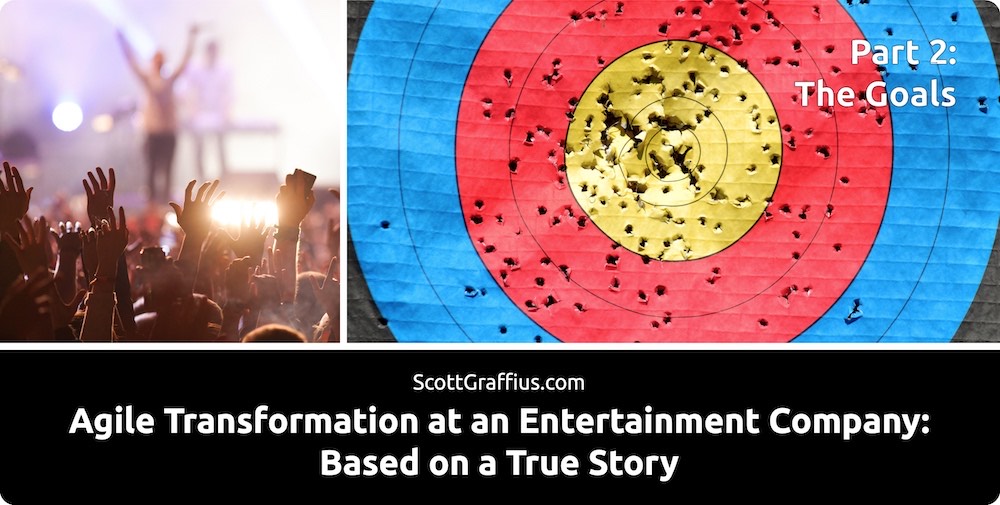
Highlights related to the goals follow.
The executive vice president (EVP) identified his top three desired outcomes:
- Accelerate the development and delivery of products and services—to be faster than the earlier baseline of 6-12 months,
- Improve the satisfaction of the Scrum Team—to be the same or better than it was earlier with the traditional/waterfall approach, and
- Improve the satisfaction of stakeholders—to also to be the same or better than it was earlier with the traditional/waterfall approach.
I individually met with and carefully listened to each member of the Scrum Team. There were recurring themes. We then met as a group and I asked them to identify their top two or three goals. They discussed the matter, voted, and decided on these:
- Meet or exceed the expectations of management, and
- Deliver valuable products.
I individually met with executives from different departments (the stakeholders). In every case, they related that things were OK with the earlier traditional/waterfall approach, but that things were worse now. The stakeholders indicated that, with the earlier approach, someone on the project team worked with their group to gather requirements, and around 6-12 months later the results were deployed. However, it was reported that with the then-current approach, the projects' purpose and requirements were not understood, and that what was produced was unusable. The goals of the stakeholders were:
- For them or their representatives to be as—or more—involved as earlier with the traditional/waterfall approach, and
- Get a usable product as often as—or more frequently than—earlier with the traditional/waterfall approach.
Here's a recap of everyone's goals. The EVP wants the development and delivery of products and services to be faster than 6-12 months, improved satisfaction of the Scrum Team, and improved satisfaction of stakeholders. The Scrum Team wants to meet or exceed expectations of management, and deliver valuable products. The stakeholders want (themselves or via their representatives) to be more involved in requirements/user stories and get useable project-delivered products more frequently than every 6-12 months.
Everyone permitted their goals to be shared with others. After discussing the subject with the EVP, I wrote the goals on oversize paper and posted it in a common area proximate to the Scrum Team and accessible to the stakeholders.
Highlights on the environment, roles, and practices—primarily focused on the Scrum Team—follow.
Agile Transformation at an International Media Conglomerate: Based on a True Story continues with Part Three: The Environment.

© Copyright 2019 Scott M. Graffius. All rights reserved. This material may not be published, broadcast, rewritten or redistributed without the express written permission of Scott M. Graffius.

Agile Transformation at an International Media Conglomerate: Based on a True Story | Part Three

Agile Transformation at an International Media Conglomerate: Based on a True Story
Scott M. Graffius, CEO of Exceptional PPM and PMO Solutions™, helps companies achieve their strategic objectives and business initiatives through project management leadership. A fantastic agile transformation outcome with a client organization in the entertainment industry was the inspiration for Scott's award-winning book, Agile Scrum: Your Quick Start Guide with Step-by-Step Instructions. This is the story behind the book—told by Scott. Identifying details have been changed and certain elements are not included.
This article is the third installment of the eight-part story. If you haven't already read the earlier parts, you can find them here:
Part Three: The Environment

Highlights on the environment including roles and practices—primarily focused on the Scrum Team—follow.
I learned that the Scrum Team was composed of 16 people: one Scrum Master, one Product Owner, and 14 Development Team members. Both the Scrum Master and the Product Owner explained that they were familiar with agile, but that they had no prior work experience with agile/Scrum and no related training—except for what was provided by the value-added reseller (VAR). The Development Team consisted of 14 people: a technical architect, a UI designer, a business analyst, seven developers, three testers, and a technical writer. Eleven of the 14 members of the Development Team had no prior work experience with agile/Scrum and no related training—except for what was provided by the VAR. Of the 16 people on the Scrum Team, 15 were local (at an office in the greater Los Angeles area), and one—the Product Owner—was based out of her office in Paris, France.
Of the 16 people on the Scrum Team, two—the Scrum Master and the Product Owner—were full time on the project. All of the others were allocated about 50% on the project.
I was given a copy of the training binder left by the VAR. I was told that the contents—about 500 pages—reflected the totality of the training and reference material. The training session, led by the VAR, was attended by the Scrum Master and the all of the Development Team members. The executive vice president (EVP) attended portions. The Product Owner attended portions, listening by phone. The first page in the binder covered the Agile Manifesto, the second page was a two-column table which compared and contrasted waterfall and Scrum (e.g., waterfall freezes scope, Scrum freezes schedule), and the third page showed success rates of waterfall vs. Scrum (e.g., 29% of waterfall projects fail vs. 9% of agile projects). The remaining pages provided information about the VAR company and detailed instructions on how to use their software product. That constituted the training.
The Product Owner, Scrum Master, and Development Team reported that they followed the training and instructions provided by the VAR. I won't delineate the then-current roles further or describe all of the events and artifacts. However, some examples follow.
The Product Owner created a product vision statement and stored it in the software, but nobody else remembered seeing it.
The Product Owner created a product backlog in the software, but nobody else claimed to have seen it.
The Scrum Master facilitated a Sprint Planning event where the Development Team estimated work in terms of complexity, and the results were recorded in the software tool. It was reported that—due to the time difference—the Product Owner did not attend Sprint Planning meetings.
It was communicated that during Sprint execution, the Scrum Master would ask the Development Team if they had any notable progress; and only if the answer was yes, there was a Daily Scrum. As a result, the Daily Scrum event occurred around once or twice a week. When the meeting took place, the Scrum Master did a quick interview with each member of the Development Team and noted the results in the software tool.
I was told that the team followed the recommendation of the VAR for the sprint duration of four weeks.
The Sprint Reviews were attended by the Scrum Master, the Product Owner (remotely), all of the Development Team members, and the EVP. However, the other stakeholders did not attend the events. On average, about half of the work planned and committed to the sprint was "done." Both "done" and not-"done" items were demonstrated at the Sprint Review.
The Scrum Master reported that the team did conduct a Retrospective event at the end of each sprint and that the results were saved in the software tool. When I reviewed the information, I saw comments such as "we worked very hard" under the what went well category. Everything under the "what didn't go so well/opportunities for improvements" category were ideas for enhancement requests for the software tool. I was informed that the VAR instructed staff to convert everything that didn't go well into a suggestion for a future general release of the software or a request for a custom enhancement of the software.
None of the work from any of the sprints was released.
Agile Transformation at an International Media Conglomerate: Based on a True Story continues with Part Four: The Options.

© Copyright 2019 Scott M. Graffius. All rights reserved. This material may not be published, broadcast, rewritten or redistributed without the express written permission of Scott M. Graffius.

Agile Transformation at an International Media Conglomerate: Based on a True Story | Part Four

Agile Transformation at an International Media Conglomerate: Based on a True Story
Scott M. Graffius, CEO of Exceptional PPM and PMO Solutions™, helps companies achieve their strategic objectives and business initiatives through project management leadership. A fantastic agile transformation outcome with a client organization in the entertainment industry was the inspiration for Scott's award-winning book, Agile Scrum: Your Quick Start Guide with Step-by-Step Instructions. This is the story behind the book—told by Scott. Identifying details have been changed and certain elements are not included.
This article is the fourth installment of the eight-part story. If you haven't already read the earlier parts, you can find them here:
Part Four: The Options

After gaining a broader and deeper understanding of the organization including their Scrum implementation, I met with the executive vice president (EVP) and we discussed next steps. I presented three options:
- No change,
- Revert to the earlier waterfall-only model, or
- "We can try different things" (aligned with the value of openness) with the objective of improving their agile implementation and achieving their goals.
I said, "we can try different things" because while I believed that changes would likely result in improvements, success could not be guaranteed. I also said, "we can try different things" because any meaningful change would require the cooperation and collaboration of many people. The EVP decided on the third option: trying different things.
The doing of "different things" started with training. I first met with the EVP. I then met with the Scrum Master in several one-on-one meetings. And since he was committed to education and improvement, he later on completed the Certified ScrumMaster (CSM) training and certification. The Product Owner was unable to attend the office in person for one-on-one training, but we communicated by phone and Skype. The EVP soon decided that the Product Owner needed to be co-located with the Scrum Team. He found a new Product Owner within the organization. I met with the new Product Owner in multiple one-on-one sessions. And—similar to what occurred with the Scrum Master—since the new Product Owner was committed to education and improvement, he subsequently completed the Certified Scrum Product Owner (CSPO) training and certification. I delivered training to the Development Team as a group. It included an overview and more in-depth coverage of certain topics such as pair programming and technical debt. Later on, some Development Team members completed the Certified Scrum Developer (CSD) training and certification. Stakeholder training follows next.
I delivered a one-hour overview of Scrum to the executive stakeholders in a group session. The attendees asked questions and made comments throughout the meeting. One stakeholder suggested that we do what the American Management Association says is best for Scrum. Then other attendees mentioned additional potential sources for information on agile. I explained that different organizations may have their own perspective on what works well for agile/Scrum, and that one way to go (I mentioned this in part to continue their engagement, involvement, and buy-in) is to look to the Scrum Alliance, a leading authority on the subject, but also see if others have ideas that are aligned with the authority and also fit the desired future state of the organization. I committed to doing the research and the stakeholders thanked me in advance.
I already had a library of 76 items on agile/Scrum—consisting of material from the Scrum Alliance, Project Management Institute, Deloitte Touche Tohmatsu, Gartner, KPMG, Harvard Business Review, IEEE, MIT, Forbes, and many others. I expanded it to include sources mentioned by stakeholders during the training session and I diligently reviewed all of the content. The diverse sources identified several values and practices as being central in successful Scrum implementations, and such factors were typically consistent with guidelines from the Scrum Alliance. I then met with each of the stakeholders individually and presented them with a summary of information from the Scrum Alliance and others.
I facilitated a follow-up group meeting with the executive stakeholders. Information from the one-hour training and the diverse sources was summarized. The stakeholders concluded that the central problem with the then-current implementation was that people were not following good practices. They then discussed, voted, and identified what they viewed as the high-level top 10 success factors for a Scrum implementation at the organization based on the previously presented information. In no particular order, the top 10 items were:
- Support from management;
- Each member of the Scrum Team (Scrum Master, Product Owner, and Development Team) is 100% allocated to the project;
- There is an agile coach, agile Project Management Office or agile Center of Excellence;
- Satisfaction is a crucial metric;
- The Scrum Team has no more than 11 people;
- The Scrum Team is co-located;
- There are consistent practices and processes;
- There is a digital wallboard or other information radiator;
- There are frequent and high-quality interactions; and
- There is continuous improvement/inspect and adapt.
Some of the items overlap/are not mutually exclusive, and the items are not exhaustive. I thanked the executive stakeholders for their support, and I told them that the 10 factors are built into the go-forward plan. The stakeholders expressed their appreciation.
The EVP and I conducted a mini-retrospective on the training sessions. The EVP was enthusiastic about what we've done so far, and he said that morale had improved. He authorized company-paid CSM, CSPO, and CSD trainings and certifications for staff (mentioned earlier). The EVP said we could advance to the next stage: piloting changes. I asked if he was open to terminating the use of the software tool introduced by the value-added reseller (VAR). He initially said that so much time and money had been invested in it that it would be hard to justify doing so. I said it differently: "We can try different things" could mean putting the software tool on vacation for a period. He agreed. We moved to the pilot—which involved doing many things differently. Examples follow.
Agile Transformation at an International Media Conglomerate: Based on a True Story continues with Part Five: The Pilot — Vision, Roadmap and Release Plan, and Product Backlog.

© Copyright 2019 Scott M. Graffius. All rights reserved. This material may not be published, broadcast, rewritten or redistributed without the express written permission of Scott M. Graffius.

Agile Transformation at an International Media Conglomerate: Based on a True Story | Part Five

Agile Transformation at an International Media Conglomerate: Based on a True Story
Scott M. Graffius, CEO of Exceptional PPM and PMO Solutions™, helps companies achieve their strategic objectives and business initiatives through project management leadership. A fantastic agile transformation outcome with a client organization in the entertainment industry was the inspiration for Scott's award-winning book, Agile Scrum: Your Quick Start Guide with Step-by-Step Instructions. This is the story behind the book—told by Scott. Identifying details have been changed and certain elements are not included.
This article is the fifth installment of the eight-part story. If you haven't already read the earlier parts, you can find them here:
Part Five: The Pilot – Vision, Roadmap and Release Plan, and Product Backlog

We advanced to the pilot—which included doing many things differently. Examples follow.
The Product Owner and I discussed techniques on developing a product vision statement. He opted to use the template attributed to Geoffrey Moore. The Product Owner created a draft of the vision and sent it with a request for feedback to the stakeholders. After receiving feedback, the Product Owner revised and finalized the product vision. He wrote the statement on oversize paper and posted it in a prominent location where the Scrum Team (Scrum Master, Product Owner, and Development Team) and stakeholders could easily see it.
The Product Owner and I then discussed techniques on creating and maintaining a product roadmap/release plan. He opted for a simple table with four rows and four columns. The rows included:
- Name (the title of the product or major release),
- Goal (the reason for creating it),
- Features (a high-level list of features), and
- Estimated number of sprints.
For the columns, there was one for each quarter of the year. Similar to what was done with the product vision, the Product Owner sent the plan with a request for feedback to the stakeholders. After receiving feedback, the Product Owner revised and the plan, wrote it on oversize paper, and posted it next to the product vision statement.
Aspects of team formation were covered already. The new Scrum team totaled 11 people. All were co-located and 100% allocated to the project.
The Product Owner and I discussed techniques on developing and maintaining the product backlog. He opted to employ a simple table format with six columns:
- ID#,
- User story/description,
- Category (he decided on four types: feature, bug, technical debt, and other),
- Story point estimate for complexity,
- Priority based on business value, and
- Status.
To help with user stories, the Product Owner often referenced the INVEST (Independent, Negotiable, Valuable, Estimable, Small, and Testable) model developed by Bill Wake. For priority, the Product Owner initially used the MoSCoW method (Must have, Should have, Could have, or Won't have). Later, the Product Owner found the business value/risk method (where each item is rated as high or low in two dimensions—business value and risk, ...) to be the most beneficial, and the Product Owner continues to use that approach today. In a session facilitated by the Scrum Master, the Product Owner presented the user stories to the Development Team, and participants provided story points (using physical cards for the exercise) for estimates of complexity of each item. Later, the team tried t-shirt sizing—S, M, L, and XL designations—for estimates of complexity, but they decided to return to story points.
Previously, sprints were four weeks in length. Now the team was using the shorter duration of two weeks. A key benefit was that the Scrum value of focus was improved.
Agile Transformation at an International Media Conglomerate: Based on a True Story continues with Part Six: The Pilot — Sprint Planning and Sprint Execution.

© Copyright 2019 Scott M. Graffius. All rights reserved. This material may not be published, broadcast, rewritten or redistributed without the express written permission of Scott M. Graffius.

Agile Transformation at an International Media Conglomerate: Based on a True Story | Part Six

Agile Transformation at an International Media Conglomerate: Based on a True Story
Scott M. Graffius, CEO of Exceptional PPM and PMO Solutions™, helps companies achieve their strategic objectives and business initiatives through project management leadership. A fantastic agile transformation outcome with a client organization in the entertainment industry was the inspiration for Scott's award-winning book, Agile Scrum: Your Quick Start Guide with Step-by-Step Instructions. This is the story behind the book—told by Scott. Identifying details have been changed and certain elements are not included.
This article is the sixth installment of the eight-part story. If you haven't already read the earlier parts, you can find them here:
- Part One: The Call;
- Part Two: The Goals;
- Part Three: The Environment;
- Part Four: The Options; and
- Part Five: The Pilot – Vision, Roadmap and Release Plan, and Product Backlog.
Part Six: The Pilot – Sprint Planning and Sprint Execution

The Product Owner, Scrum Master and I discussed sprint planning techniques. The Scrum Master decided that the meeting event would be handled via two separate sessions—part 1 (what will be committed to for the upcoming sprint) and part 2 (how to accomplish the work identified in part 1).
For sprint planning part 1, the timebox (not to exceed duration) for the meeting was calculated as:
- 2
- multiplied by the number of weeks in the upcoming sprint (2 in this case),
- which equaled 4 hours for the event.
The Scrum Master made the following information visible during the event: start and end dates for the sprint, (after a sprint was completed) the results of the last sprint review event, and (after a sprint was completed) the results from the last sprint retrospective event. The Product Owner reminded the Development Team about the product vision statement, and the Product Owner shared the sprint goal (such as "implement shopping cart functionality ..."). The Development Team determined their capacity in work hours for the upcoming sprint. It was calculated as:
- the number of people in the Development Team
- multiplied by the number of project productive hours (which excluded time outside the sprint such as company meetings, trainings, vacation time, etc.) per workday
- multiplied by number of workdays in the sprint.
(Estimation via story points, and prioritization by the Product Owner were already taken care of.)
For each item in the product backlog, participants discussed the user stories/requirements including acceptance criteria, assumptions, dependencies, risks, and anything else requiring a conversation to get a good understanding of the item. The Development Team then committed to the entries which they thought could be completed in the upcoming sprint. The technique they employed involved asking "Can we do this first item in the product backlog?" If the answer was yes, they selected it and proceeded to the next item and continued until the team believed that no more work could be done in the sprint. After the Development Team had worked together and had data on actual velocity (the number of story points completed in a sprint), they also considered that historical metric—comparing it with story points for items in the sprint. The Product Owner updated the product backlog, identifying the items committed by the Development Team to be done for the upcoming sprint.
For sprint planning part 2, the timebox for the meeting was calculated as:
- 2
- multiplied by the number of weeks in the upcoming sprint (2 in this case),
- which equaled 4 hours for the event.
The Scrum team created the sprint backlog. It had the following columns:
- ID#,
- Description,
- Story points,
- Task information (meetings, designs, coding, code review, testing, etc.),
- Estimation in hours (they adopted the practice that if effort is greater than eight hours, split the task into smaller ones),
- Owner (where members of the Development Team self-assign tasks),
- Status, and
- Hours of work remaining.
During the meeting, the Scrum team compared the total estimated work hours for the sprint with the Development Team’s capacity (mentioned under the part 1 meeting) for the sprint. If the Development Team believed that the sprint backlog contained too much work to be done during the sprint, they collaborated with the Product Owner to remove one or more items. If the Development Team believed they could handle more work during the sprint, they worked with the Product Owner to move one or more of the high priority items from the product backlog to the sprint backlog.
The Product Owner, Scrum Master and I discussed sprint execution. Select examples of what was decided and done are highlighted next.
The Development Team set up a task board (also known as a Scrum board) to reflect the work in the current iteration. They went with a simple format. The board depicted work in rows and columns where rows included work items, and columns reflected status (To Do, Doing, and Done). Work was addressed from top (highest priority) to bottom, and work migrated from left to right on the task board as it progressed. The task board is also covered in the daily Scrum meeting.
The Scrum Master decided to use a sprint burndown chart to track and communicate progress during the sprint. He set it up and updated it each workday, usually immediately after the daily Scrum meeting.
The Scrum Master created an impediment backlog to capture things preventing the team from progressing or improving. This backlog was updated daily, typically immediately after the daily Scrum meeting.
At the daily Scrum meeting event, the Development Team shared status, plans, and any impediments. Before this pilot with changes, the team was not conducting the daily Scrum (or updating the task board, burndown chart, and impediments backlog) consistently. Under the pilot (and subsequently), the Development Team met for up to 15 minutes (timebox) each workday, and it was conducted at the same time (10:00 a.m.) each day. At this daily stand-up session, the Development Team and the Scrum Master met where the task board, sprint burndown chart, and impediment backlog were posted. Each Development Team member described what he/she worked on since the last Scrum meeting, and he/she updated the task board. Next, the same Development Team member explained what he/she would work on that day, and he/she updated the task board. Lastly, the same Development Team member reported any impediments. (The Scrum Master recorded any issues in the impediments backlog. If a discussion was required, it took place immediately after the daily Scrum. The Scrum Master helped resolve impediments.) The steps were repeated for other members of the Development Team.
The Scrum Team built an increment of functionality during every sprint, and the increment was potentially shippable because the Product Owner might decide for it to be implemented at the end of the sprint. Said differently, potentially shippable is defined by a state of confidence or readiness, and shipping is a business decision. Commencing with the pilot, the organization started releasing products as often as every sprint (two weeks).
Agile Transformation at an International Media Conglomerate: Based on a True Story continues with Part Seven: The Pilot — Sprint Review and Sprint Retrospective.

© Copyright 2019 Scott M. Graffius. All rights reserved. This material may not be published, broadcast, rewritten or redistributed without the express written permission of Scott M. Graffius.

Agile Transformation at an International Media Conglomerate: Based on a True Story | Part Seven

Agile Transformation at an International Media Conglomerate: Based on a True Story
Scott M. Graffius, CEO of Exceptional PPM and PMO Solutions™, helps companies achieve their strategic objectives and business initiatives through project management leadership. A fantastic agile transformation outcome with a client organization in the entertainment industry was the inspiration for Scott's award-winning book, Agile Scrum: Your Quick Start Guide with Step-by-Step Instructions. This is the story behind the book—told by Scott. Identifying details have been changed and certain elements are not included.
This article is the seventh installment of the eight-part story. If you haven't already read the earlier parts, you can find them here:
- Part One: The Call;
- Part Two: The Goals;
- Part Three: The Environment;
- Part Four: The Options;
- Part Five: The Pilot – Vision, Roadmap and Release Plan, and Product Backlog; and
- Part Six: The Pilot – Sprint Planning and Sprint Execution.
Part Seven: The Pilot – Sprint Review and Sprint Retrospective

The Scrum team—Product Owner, Scrum Master, and the Development Team—and I discussed techniques for the sprint review. The event is sometimes referred to as the sprint demo. The timebox (not to exceed duration) in hours for the meeting was calculated as:
- 1
- multiplied by the number of weeks in the upcoming sprint (2 in this case),
- which equaled 2 hours for the event.
Participants included the Product Owner, Scrum Master, Development Team, and stakeholders. All of the stakeholders (the executives mentioned in earlier parts of the story) were invited to and attended the sprint review. At the session, the Product Owner welcomed attendees and communicated the agenda. He pointed out the sprint goal, which was displayed on the wall in the meeting room. Next, the Development Team listed the work that was committed to the sprint. They then listed the work that was completed and the work that was not completed. For each completed story/feature, the Development Team demonstrated the "done" working functionality and answered questions. Stakeholders were invited to interact with the "done" working functionality and they did so. Then the entire group reviewed the product backlog and collaborated on what to do next. The Product Owner incorporated feedback into the Product Backlog. It involved adding new items to the backlog and/or re-prioritizing existing items. After the sprint review, the Scrum Master incorporated any feedback related to problems into the impediments backlog.
The Scrum Master and I discussed techniques for the sprint retrospective event. The timebox in hours for the meeting was calculated as:
- 0.75
- multiplied by the number of weeks in the upcoming sprint (2 in this case),
- which equaled 1.50 hours for the event.
At the sprint retrospective, the Development Team identified what went well, what didn't go well, and improvements to be implemented in the upcoming sprint—an example of inspection and adaptation. For improvements to be implemented, each member of the Development Team wrote their top one, two or three suggestions on sticky notes. Each idea got its own sticky note. Then the Development Team grouped the sticky notes into categories/themes, and they discussed the items and voted to determine the top one (initially limited to one, later it was raised to two) for adaptation and improvement. The Development Team committed to the change and the Scrum Master recorded the information.
Agile Transformation at an International Media Conglomerate: Based on a True Story concludes with Part Eight: The Success.

© Copyright 2019 Scott M. Graffius. All rights reserved. This material may not be published, broadcast, rewritten or redistributed without the express written permission of Scott M. Graffius.

Agile Transformation at an International Media Conglomerate: Based on a True Story | Part Eight

Agile Transformation at an International Media Conglomerate: Based on a True Story
Scott M. Graffius, CEO of Exceptional PPM and PMO Solutions™, helps companies achieve their strategic objectives and business initiatives through project management leadership. A fantastic agile transformation outcome with a client organization in the entertainment industry was the inspiration for Scott's award-winning book, Agile Scrum: Your Quick Start Guide with Step-by-Step Instructions. This is the story behind the book—told by Scott. Identifying details have been changed and certain elements are not included.
This article is the final installment of the eight-part story. If you haven't already read the earlier parts, you can find them here:
- Part One: The Call;
- Part Two: The Goals;
- Part Three: The Environment;
- Part Four: The Options;
- Part Five: The Pilot – Vision, Roadmap and Release Plan, and Product Backlog;
- Part Six: The Pilot – Sprint Planning and Sprint Execution; and
- Part Seven: The Pilot – Sprint Review and Sprint Retrospective.
Part Eight: The Success

By adopting an agile mindset and providing improved engagement, collaboration, transparency, and adaptability via Scrum's values, roles, events, and artifacts, the results were excellent. After one sprint, satisfaction ratings for the Development Team and stakeholders were higher than the target. After three sprints, the output of the Scrum Team became consistent and predictable, satisfaction increased even further, and all of the seven goals mentioned earlier were achieved. Here's an overview:
🎯 Goal 1
- Source: This goal was identified by the EVP (executive vice president)
- Desired outcome: Develop and deliver products and services faster than 6-12 months
- Result: The goal was achieved (with the agile transformation, delivery occurred as often as every two weeks)
🎯 Goal 2
- Source: This goal was identified by the EVP
- Desired outcome: Improve the satisfaction of the Scrum Team
- Result: The goal was achieved
🎯 Goal 3
- Source: This goal was identified by the EVP
- Desired outcome: Improve the satisfaction of the stakeholders
- Result: The goal was achieved
🎯 Goal 4
- Source: This goal was identified by the Scrum Team (Scrum Master, Product Owner, and the Development Team)
- Desired outcome: Meet or exceed the expectations of management
- Result: The goal was achieved
🎯 Goal 5
- Source: This goal was identified by the Scrum Team
- Desired outcome: Deliver valuable products/services
- Result: The goal was achieved
🎯 Goal 6
- Source: This goal was identified by the stakeholders
- Desired outcome: For stakeholders or their representatives to be more involved in requirements
- Result: The goal was achieved
🎯 Goal 7
- Source: This goal was identified by the stakeholders
- Desired outcome: Get useable products delivered more frequently than 6-12 months
- Result: The goal was achieved (with the agile transformation, delivery occurred as often as every two weeks)
The EVP, Scrum Team, and stakeholders declared the pilot a success and they made this implementation of Scrum the preferred approach for the development and delivery of products and services going forward.
In addition to achieving the goals summarized above, the agile transformation also supported the organization's efforts to innovate and drive their competitive advantage. It became more successful. As the business grew, so has the number of Scrum teams. Originally numbering one, the division presently has six Scrum teams.
This concludes Agile Transformation at an International Media Conglomerate: Based on a True Story. The agile transformation experience was the inspiration for Scott M. Graffius’ book, Agile Scrum: Your Quick Start Guide with Step-by-Step Instructions. The publication helps technical and non-technical teams develop and deliver products in short cycles with rapid adaptation to change, fast time-to-market, continuous improvement, and more. The book has garnered 17 first place awards and credit is shared with Chris Hare and Colin Giffen, the technical editors on the publication. Scott and Agile Scrum: Your Quick Start Guide with Step-by-Step Instructions have been featured in Yahoo Finance, the Boston Herald, NBC WRAL, the Dallas Business Journal, the PM World Journal, Learning Solutions, Innovation Management, and additional media publications. A trailer, high-resolution images, reviews, and a detailed list of awards are in the digital media kit. The book is available at Amazon, Barnes & Noble, Strand Books, Harvard Book Store, Books-a-Million, The Booksmith, Hudson Booksellers, Savoy Bookshop & Café, Compass Books at SFO/Books Inc., Books & Books - Miami, University Press Books - Berkeley, and other retailers, distributors, and partners in the United States and around the world.

© Copyright 2019 Scott M. Graffius. All rights reserved. This material may not be published, broadcast, rewritten or redistributed without the express written permission of Scott M. Graffius.

New Book: "Agile Transformation: A Brief Story of How an Entertainment Company Developed New Capabilities and Unlocked Business Agility to Thrive in an Era of Rapid Change"
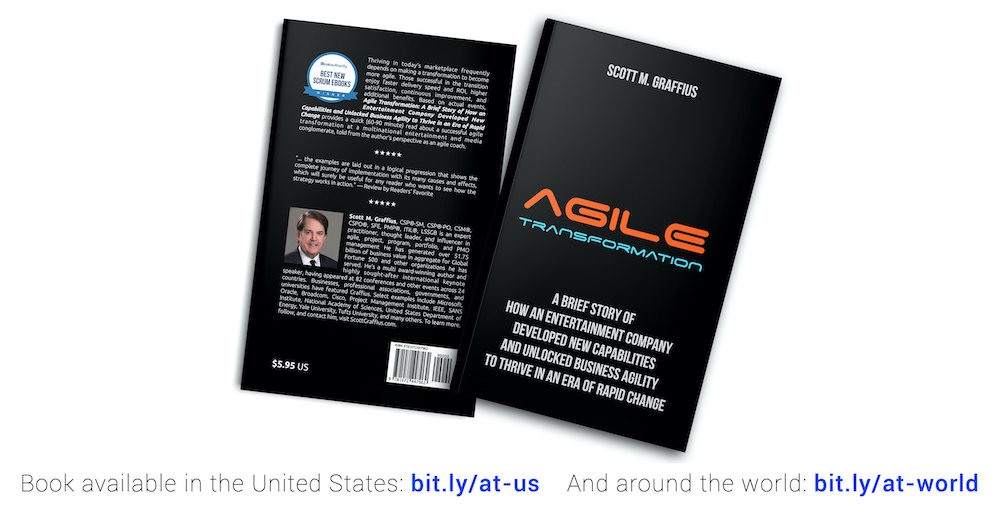
Agile Transformation was previously available in 34 countries. This article was updated on May 22, 2020 to reflect the expanded distribution. It's now available in 46 countries.
About Agile Transformation: A Brief Story of How an Entertainment Company Developed New Capabilities and Unlocked Business Agility to Thrive in an Era of Rapid Change
Thriving in today's marketplace frequently depends on making a transformation to become more agile. Those successful in the transition enjoy faster delivery speed and ROI, higher satisfaction, continuous improvement, and additional benefits.
Based on actual events, Agile Transformation: A Brief Story of How an Entertainment Company Developed New Capabilities and Unlocked Business Agility to Thrive in an Era of Rapid Change provides a quick (60-90 minute) read about a successful agile transformation at a multinational entertainment and media company, told from the author's perspective as an agile coach.
The award-winning book by Scott M. Graffius is available in paperback and ebook/Kindle in the United States and around the world. Some links by country follow.
- 🇦🇺 Australia
- 🇦🇹 Austria
- 🇧🇷 Brazil
- 🇨🇦 Canada
- 🇨🇿 Czech Republic
- 🇩🇰 Denmark
- 🇫🇮 Finland
- 🇫🇷 France
- 🇩🇪 Germany
- 🇬🇷 Greece
- 🇮🇳 India
- 🇮🇪 Ireland
- 🇯🇵 Japan
- 🇱🇺 Luxembourg
- 🇲🇽 Mexico
- 🇳🇱 Netherlands
- 🇳🇿 New Zealand
- 🇪🇸 Spain
- 🇸🇪 Sweden
- 🇨🇭 Switzerland
- 🇦🇪 United Arab Emirates
- 🇬🇧 United Kingdom
- 🇺🇸 United States
The book appeared on Amazon's "Hot New Releases" list as shown in the following screen shot.
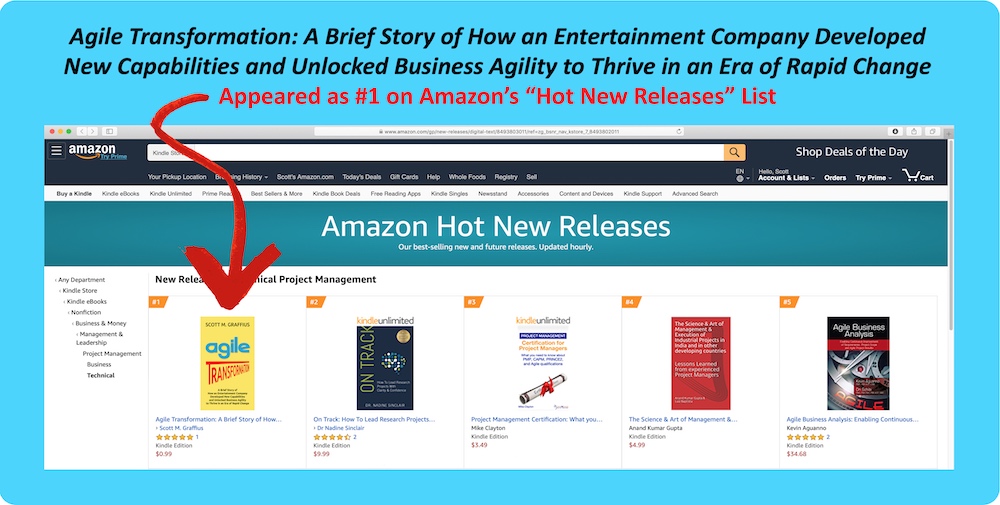
You’re invited to watch the trailer, visit the website, read the blog, and connect on social. Like Agile Transformation on Facebook, and follow Agile Transformation on Twitter, Instagram, and LinkedIn.

About the Author
Follow @scottgraffius
Scott M. Graffius, CSP-SM, CSP-PO, CSM, CSPO, PMP, ITIL, LSSGB is a project management expert, consultant, speaker, and author. He is a Principal Consultant and the CEO of Exceptional PPM and PMO Solutions™, a professional services firm, where he helps clients strengthen their project management capabilities and realize their strategic objectives and business initiatives. Before that, he ran and supervised the delivery of projects and programs in public and private companies with businesses ranging from e-commerce to advanced technology, manufacturing, entertainment, and more. Scott and his award-winning book on agile project management, Agile Scrum: Your Quick Start Guide with Step-by-Step Instructions, have been featured in Yahoo Finance, the Boston Herald, Learning Solutions, Informa, Innovation Management, and additional media publications. His second title, Agile Transformation: A Brief Story of How an Entertainment Company Developed New Capabilities and Unlocked Business Agility to Thrive in an Era of Rapid Change, was published in April 2019. Scott regularly speaks at conferences and other events around the world.
His full bio is available here.
Connect with Scott on:


© Copyright 2019 Scott M. Graffius. All rights reserved. This material may not be published, broadcast, rewritten or redistributed without the express written permission of Scott M. Graffius.

Scott M. Graffius Named Author of the Week by AUTHORSWEEK for "Agile Transformation: A Brief Story of How an Entertainment Company Developed New Capabilities and Unlocked Business Agility to Thrive in an Era of Rapid Change"
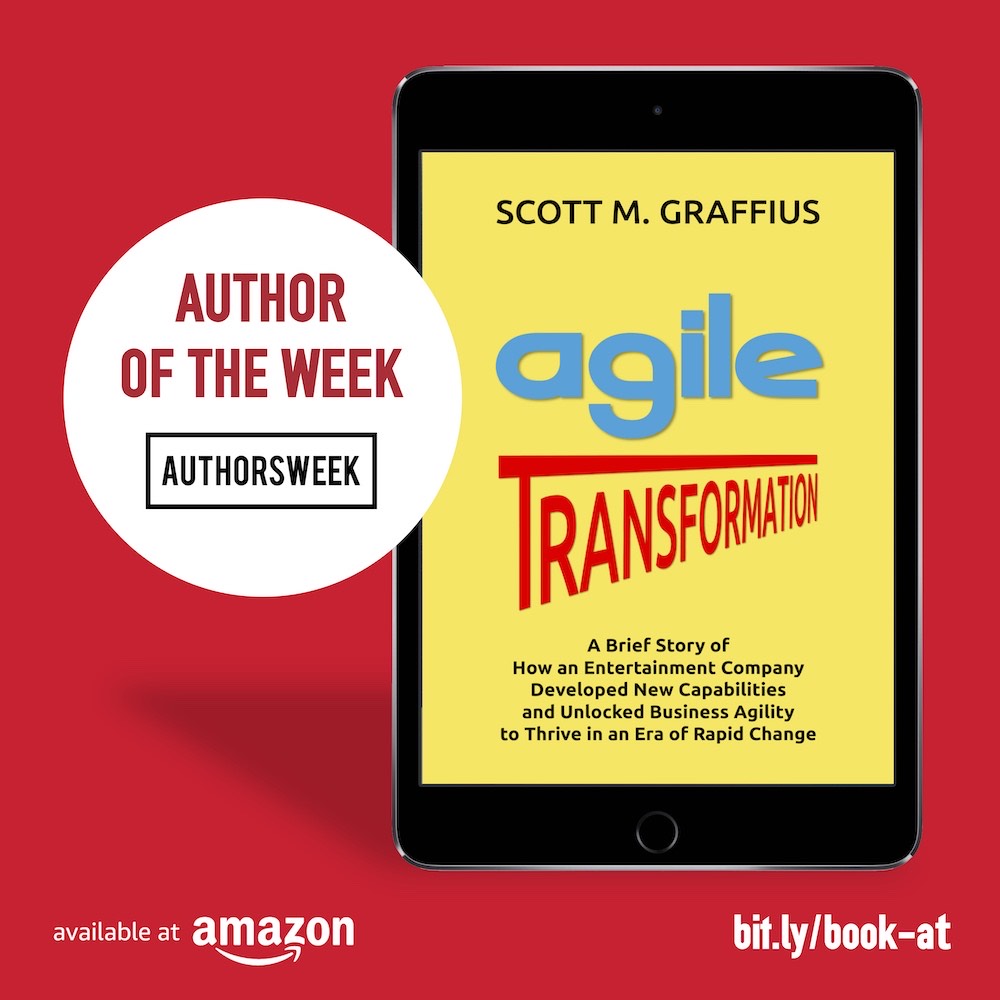
AUTHORSWEEK named Scott M. Graffius as Author of the Week for his new title, Agile Transformation: A Brief Story of How an Entertainment Company Developed New Capabilities and Unlocked Business Agility to Thrive in an Era of Rapid Change. This is Scott's second book.

About the Author

Scott M. Graffius is a project management expert, consultant, speaker, and author. He is CEO of Exceptional PPM and PMO Solutions™, a professional services firm, where he partners with client companies to help them achieve their strategic objectives and business initiatives through project management leadership. Before that, he ran and supervised the delivery of projects in public and private companies with businesses ranging from e-commerce to advanced technology, manufacturing, entertainment, and more. Scott's first book, Agile Scrum: Your Quick Start Guide with Step-by-Step Instructions, garnered 17 first place awards. Scott and Agile Scrum have been featured in Yahoo Finance, the Boston Herald, Learning Solutions, Informa, Innovation Management, and additional media publications. He regularly speaks at conferences and other events around the world.
His full bio is available here.
Connect with Scott on:



About Agile Transformation: A Brief Story of How an Entertainment Company Developed New Capabilities and Unlocked Business Agility to Thrive in an Era of Rapid Change

Thriving in today's marketplace frequently depends on making a transformation to become more agile. Those successful in the transition enjoy faster delivery speed and ROI, higher satisfaction, continuous improvement, and additional benefits.
Based on actual events, Agile Transformation: A Brief Story of How an Entertainment Company Developed New Capabilities and Unlocked Business Agility to Thrive in an Era of Rapid Change provides a quick (60-90 minute) read about a successful agile transformation at a multinational entertainment and media company, told from the author's perspective as an agile coach.
The award-winning book by Scott M. Graffius is available in paperback and ebook/Kindle in the United States and around the world. Some links by country follow.
- 🇦🇺 Australia
- 🇦🇹 Austria
- 🇧🇷 Brazil
- 🇨🇦 Canada
- 🇨🇿 Czech Republic
- 🇩🇰 Denmark
- 🇫🇮 Finland
- 🇫🇷 France
- 🇩🇪 Germany
- 🇬🇷 Greece
- 🇮🇳 India
- 🇮🇪 Ireland
- 🇯🇵 Japan
- 🇱🇺 Luxembourg
- 🇲🇽 Mexico
- 🇳🇱 Netherlands
- 🇳🇿 New Zealand
- 🇪🇸 Spain
- 🇸🇪 Sweden
- 🇨🇭 Switzerland
- 🇦🇪 United Arab Emirates
- 🇬🇧 United Kingdom
- 🇺🇸 United States

About AUTHORSWEEK
AUTHORSWEEK provides a weekly round-up of the latest book releases and author platform programs. For additional information, visit their website at AUTHORSWEEK.COM.

© Copyright 2019 Scott M. Graffius. All rights reserved. This material may not be published, broadcast, rewritten or redistributed without the express written permission of Scott M. Graffius.

Trailer for "Agile Transformation: A Brief Story of How an Entertainment Company Developed New Capabilities and Unlocked Business Agility to Thrive in an Era of Rapid Change"
Based on a true story, Agile Transformation: A Brief Story of How an Entertainment Company Developed New Capabilities and Unlocked Business Agility to Thrive in an Era of Rapid Change by Scott M. Graffius provides a revealing behind-the-scenes account of a successful agile implementation at a global entertainment company. You're invited to watch the trailer for the book. It runs 30 seconds.

About the Author
Scott M. Graffius is a project management expert, consultant, speaker, and author. He is CEO of Exceptional PPM and PMO Solutions™, a professional services firm, where he partners with client companies to help them achieve their strategic objectives and business initiatives through project management leadership. Before that, he ran and supervised the delivery of projects in public and private companies with businesses ranging from e-commerce to advanced technology, manufacturing, entertainment, and more. Scott's first book, Agile Scrum: Your Quick Start Guide with Step-by-Step Instructions (ISBN-13: 9781533370242), garnered 17 first place awards. Scott and Agile Scrum have been featured in Yahoo Finance, the Boston Herald, Computer Weekly, Learning Solutions, Informa, Innovation Management, and additional media publications. He regularly speaks at conferences and other events around the world.
His full bio is available here.
Connect with Scott on:



About Agile Transformation: A Brief Story of How an Entertainment Company Developed New Capabilities and Unlocked Business Agility to Thrive in an Era of Rapid Change

Thriving in today's marketplace frequently depends on making a transformation to become more agile. Those successful in the transition enjoy faster delivery speed and ROI, higher satisfaction, continuous improvement, and additional benefits.
Based on actual events, Agile Transformation: A Brief Story of How an Entertainment Company Developed New Capabilities and Unlocked Business Agility to Thrive in an Era of Rapid Change provides a quick (60-90 minute) read about a successful agile transformation at a multinational entertainment and media company, told from the author's perspective as an agile coach.
The award-winning book by Scott M. Graffius is available in paperback and ebook/Kindle in the United States and around the world. Some links by country follow.
- 🇦🇺 Australia
- 🇦🇹 Austria
- 🇧🇷 Brazil
- 🇨🇦 Canada
- 🇨🇿 Czech Republic
- 🇩🇰 Denmark
- 🇫🇮 Finland
- 🇫🇷 France
- 🇩🇪 Germany
- 🇬🇷 Greece
- 🇮🇳 India
- 🇮🇪 Ireland
- 🇯🇵 Japan
- 🇱🇺 Luxembourg
- 🇲🇽 Mexico
- 🇳🇱 Netherlands
- 🇳🇿 New Zealand
- 🇪🇸 Spain
- 🇸🇪 Sweden
- 🇨🇭 Switzerland
- 🇦🇪 United Arab Emirates
- 🇬🇧 United Kingdom
- 🇺🇸 United States

© Copyright 2019 Scott M. Graffius. All rights reserved. This material may not be published, broadcast, rewritten or redistributed without the express written permission of Scott M. Graffius.

BookAuthority Names "Agile Transformation" One of the Best New Scrum Ebooks
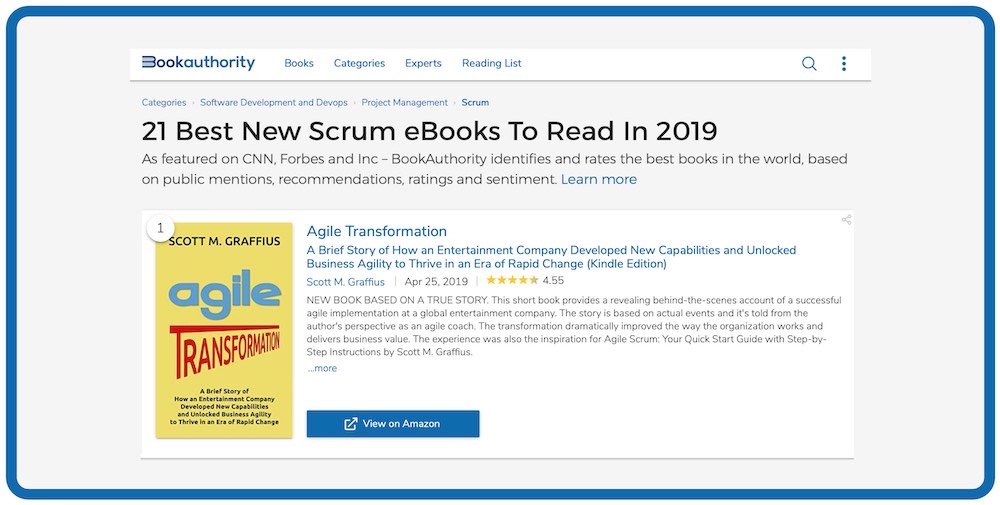
BookAuthority named Scott M. Graffius' second book, Agile Transformation: A Brief Story of How an Entertainment Company Developed New Capabilities and Unlocked Business Agility to Thrive in an Era of Rapid Change, as one of the best new ebooks on Scrum!
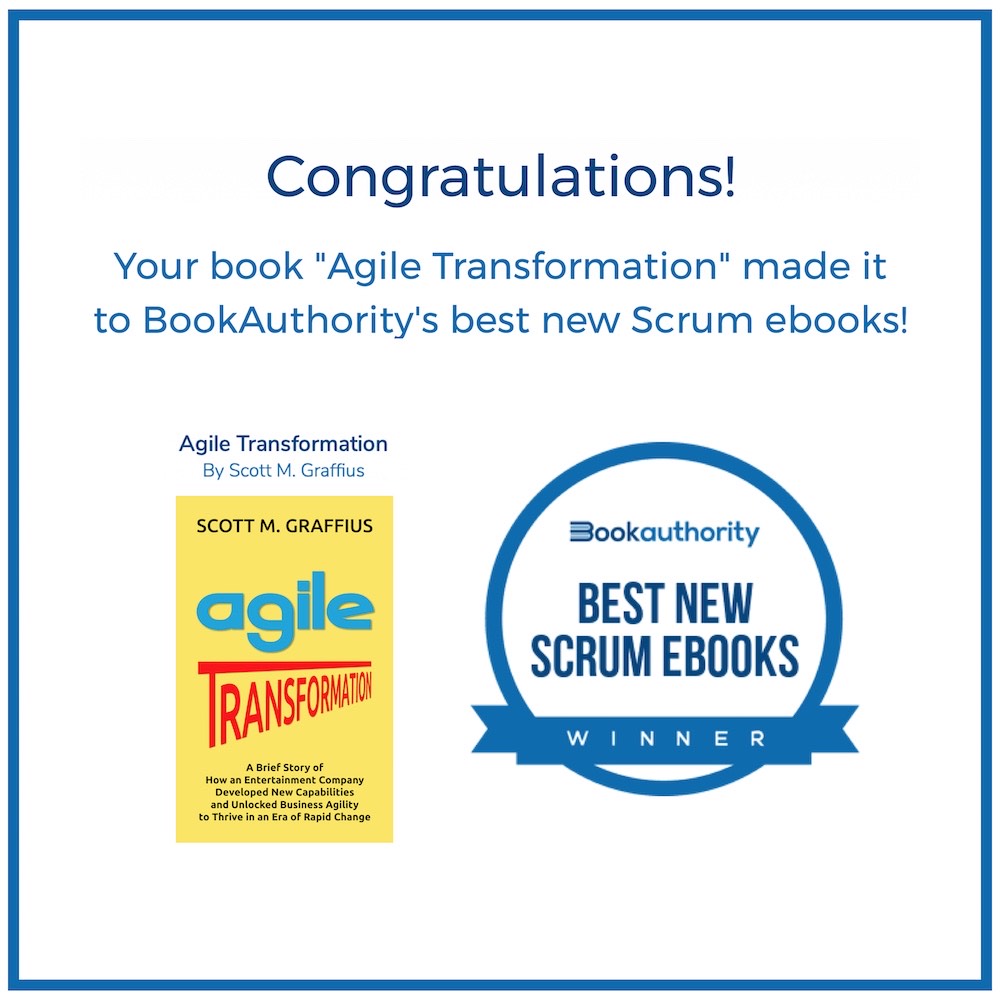

About Agile Transformation: A Brief Story of How an Entertainment Company Developed New Capabilities and Unlocked Business Agility to Thrive in an Era of Rapid Change

Thriving in today's marketplace frequently depends on making a transformation to become more agile. Those successful in the transition enjoy faster delivery speed and ROI, higher satisfaction, continuous improvement, and additional benefits.
Based on actual events, Agile Transformation: A Brief Story of How an Entertainment Company Developed New Capabilities and Unlocked Business Agility to Thrive in an Era of Rapid Change provides a quick (60-90 minute) read about a successful agile transformation at a multinational entertainment and media company, told from the author's perspective as an agile coach.
The award-winning book by Scott M. Graffius is available in paperback and ebook/Kindle in the United States and around the world. Some links by country follow.
- 🇦🇺 Australia
- 🇦🇹 Austria
- 🇧🇷 Brazil
- 🇨🇦 Canada
- 🇨🇿 Czech Republic
- 🇩🇰 Denmark
- 🇫🇮 Finland
- 🇫🇷 France
- 🇩🇪 Germany
- 🇬🇷 Greece
- 🇮🇳 India
- 🇮🇪 Ireland
- 🇯🇵 Japan
- 🇱🇺 Luxembourg
- 🇲🇽 Mexico
- 🇳🇱 Netherlands
- 🇳🇿 New Zealand
- 🇪🇸 Spain
- 🇸🇪 Sweden
- 🇨🇭 Switzerland
- 🇦🇪 United Arab Emirates
- 🇬🇧 United Kingdom
- 🇺🇸 United States

About Author Scott M. Graffius

Scott M. Graffius is a technology leader, project management expert, consultant, international speaker, and award-winning author.
Scott is a Principal Consultant and the CEO of Exceptional PPM and PMO Solutions™, a professional services firm, where he helps clients strengthen their project management capabilities and realize their strategic objectives and business initiatives. The consultancy provides advisory, training, and facilitative consulting services related to project, program, portfolio, and PMO management. The firm’s expertise spans agile, traditional waterfall, and hybrid approaches. While every engagement is unique, outcomes typically include getting more projects done, faster delivery time, improved on-budget performance, improved customer and stakeholder satisfaction, and more. Exceptional PPM and PMO Solutions™ confidently backs its services with a Delighted Client Guarantee™.
A fantastic agile transformation experience and result with a client organization in the entertainment industry was the inspiration for Scott’s first book, Agile Scrum: Your Quick Start Guide with Step-by-Step Instructions. It helps technical and non-technical teams develop and deliver products in short cycles with rapid adaptation to change, fast time-to-market, and continuous improvement—which supports innovation and drives competitive advantage. The book has garnered 17 first place awards from national and international competitions. Scott and Agile Scrum: Your Quick Start Guide with Step-by-Step Instructions have been featured in Yahoo Finance, the Boston Herald, NBC WRAL, the Dallas Business Journal, Computer Weekly, the PM World Journal, BookLife by Publisher’s Weekly, Learning Solutions, Innovation Management, and additional media publications. A trailer, high-resolution images, reviews, a detailed list of awards, and more are available in the digital media kit. His second title, Agile Transformation: A Brief Story of How an Entertainment Company Developed New Capabilities and Unlocked Business Agility to Thrive in an Era of Rapid Change, was published in April 2019.
Scott is a former vice president of project management with a publicly traded provider of diverse consumer products and services over the Internet. Before that, he ran and supervised the delivery of projects and programs in public and private organizations with businesses ranging from e-commerce to advanced technology products and services, retail, manufacturing, entertainment, and more. He has experience with consumer, business, reseller, government, and international markets, as well as experience spanning 20 countries.
Scott has a bachelor's degree in Psychology with a focus in Human Factors. He holds six professional certifications: Certified Scrum Professional (CSP), Certified ScrumMaster (CSM), Certified Scrum Product Owner (CSPO), Project Management Professional (PMP), Lean Six Sigma Green Belt (LSSGB), and IT Service Management Foundation (ITIL). He is a member of the Scrum Alliance, the Project Management Institute, and the Institute of Electrical and Electronics Engineers (IEEE). Within the IEEE, Scott is a member of the Computer Society, the Consumer Electronics Society, the Broadcast Technology Society, the Internet of Things Community, and the Consultants Network.
He has been actively involved with the Project Management Institute (PMI) in the development of professional standards. He was a member of the team which produced the Practice Standard for Work Breakdown Structures—Second Edition. Scott was a contributor and reviewer of A Guide to the Project Management Body of Knowledge—Sixth Edition and The Standard for Program Management—Fourth Edition. He was also a subject matter expert reviewer of content for the PMI EMEA Congress 2019.
Scott regularly speaks at conferences and other events around the globe where he delights audiences with presentations on agile, traditional, and hybrid project, program, portfolio, and PMO management. He integrates content on professional standards, best practices, and his first-hand experience with successful implementations. Scott uses everyday language and vibrant custom visuals to make complex topics clear and understandable, and he provides audiences with practical information they can use.
FHis full bio is available here.
Connect with Scott on:


About BookAuthority
BookAuthority curates the books recommended by the world's most successful CEOs, business leaders, and domain experts such as Elon Musk, Warren Buffett, Sheryl Sandberg, and David Allen. Only the very best books are featured on BookAuthority. To keep BookAuthority's site objective and unbiased, ratings are calculated purely based on data. BookAuthority uses a proprietary technology to identify and rate the best nonfiction books, using dozens of different signals, including public mentions, recommendations, ratings, sentiment, popularity and sales history. BookAuthority does not accept requests to feature books, nor does BookAuthority conduct business with publishers or authors. BookAuthority has been featured on CNN, Forbes and Inc. The preceding information is based on content from BookAuthority.org.

© Copyright 2019 Scott M. Graffius. All rights reserved. This material may not be published, broadcast, rewritten or redistributed without the express written permission of Scott M. Graffius.

BookAuthority Names "Agile Transformation" One of the Best Scrum Ebooks of All Time
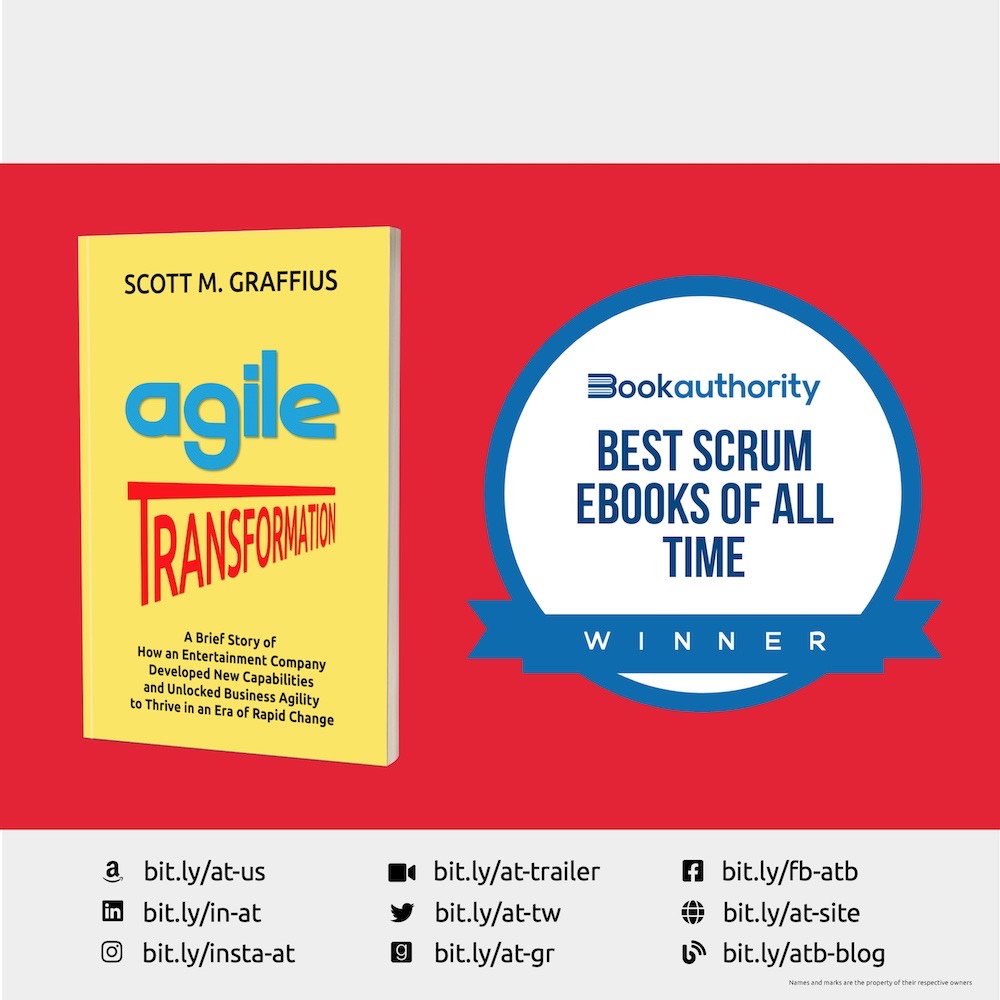
Agile Transformation: A Brief Story of How an Entertainment Company Developed New Capabilities and Unlocked Business Agility to Thrive in an Era of Rapid Change was initially offered only in ebook format. Soon after it was released, BookAuthority named Agile Transformation as one of the best *new* ebooks on Scrum! BookAuthority gave it an additional award. It's now on the list of the best Scrum ebooks of *all time.* Details on the award are available here. Thank you BookAuthority!
For those who prefer the visual and tactile experience of physical books, a paperback version of Agile Transformation was added and is also available.
Grab a copy of Agile Transformation in ebook or paperback -
● In the United States: bit.ly/at-us
● Outside the United States: bit.ly/intl-links
#Agile #AgileProjectManagement #AgileTransformation #AgileTransformationBook #AgileCoach #Author #Book #Business #Change #ChangeManagement #Entertainment #IT #ITManagement #InformationTechnology #Innovation #Leadership #Management #PMO #Product #ProjectManagement #ProjectMgmt #Scrum #Success #Tech #Technology #Transformation


About Agile Transformation: A Brief Story of How an Entertainment Company Developed New Capabilities and Unlocked Business Agility to Thrive in an Era of Rapid Change

Thriving in today's marketplace frequently depends on making a transformation to become more agile. Those successful in the transition enjoy faster delivery speed and ROI, higher satisfaction, continuous improvement, and additional benefits.
Based on actual events, Agile Transformation: A Brief Story of How an Entertainment Company Developed New Capabilities and Unlocked Business Agility to Thrive in an Era of Rapid Change provides a quick (60-90 minute) read about a successful agile transformation at a multinational entertainment and media company, told from the author's perspective as an agile coach.
The award-winning book by Scott M. Graffius is available in paperback and ebook/Kindle in the United States and around the world. Some links by country follow.
- 🇦🇺 Australia
- 🇦🇹 Austria
- 🇧🇷 Brazil
- 🇨🇦 Canada
- 🇨🇿 Czech Republic
- 🇩🇰 Denmark
- 🇫🇮 Finland
- 🇫🇷 France
- 🇩🇪 Germany
- 🇬🇷 Greece
- 🇮🇳 India
- 🇮🇪 Ireland
- 🇯🇵 Japan
- 🇱🇺 Luxembourg
- 🇲🇽 Mexico
- 🇳🇱 Netherlands
- 🇳🇿 New Zealand
- 🇪🇸 Spain
- 🇸🇪 Sweden
- 🇨🇭 Switzerland
- 🇦🇪 United Arab Emirates
- 🇬🇧 United Kingdom
- 🇺🇸 United States

About Author Scott M. Graffius

Scott M. Graffius, CSP-SM, CSP-PO, CSM, CSPO, PMP, ITIL, LSSGB is a project management expert, consultant, speaker, and author. He is a Principal Consultant and the CEO of Exceptional PPM and PMO Solutions™, a professional services firm, where he helps clients strengthen their project management capabilities and realize their strategic objectives and business initiatives. Before that, he ran and supervised the delivery of projects and programs in public and private companies with businesses ranging from e-commerce to advanced technology, manufacturing, entertainment, and more. Scott and his award-winning book on agile project management, Agile Scrum: Your Quick Start Guide with Step-by-Step Instructions, have been featured in Yahoo Finance, the Boston Herald, Learning Solutions, Informa, Innovation Management, and additional media publications. His second title, Agile Transformation: A Brief Story of How an Entertainment Company Developed New Capabilities and Unlocked Business Agility to Thrive in an Era of Rapid Change, was published in April 2019. BookAuthority named it one of the best new books on Scrum. Scott regularly speaks at conferences and other events around the world.
His full bio is available here.
Connect with Scott on:


About BookAuthority
BookAuthority curates the books recommended by the world's most successful CEOs, business leaders, and domain experts such as Elon Musk, Warren Buffett, Sheryl Sandberg, and David Allen. Only the very best books are featured on BookAuthority. To keep BookAuthority's site objective and unbiased, ratings are calculated purely based on data. BookAuthority uses a proprietary technology to identify and rate the best nonfiction books, using dozens of different signals, including public mentions, recommendations, ratings, sentiment, popularity and sales history. BookAuthority does not accept requests to feature books, nor does BookAuthority conduct business with publishers or authors. BookAuthority has been featured on CNN, Forbes and Inc. The preceding information is based on content from BookAuthority.org.

© Copyright 2019 Scott M. Graffius. All rights reserved. This material may not be published, broadcast, rewritten or redistributed without the express written permission of Scott M. Graffius.

